Space
The planet Jupiter; Everything you need to know
Published
4 months agoon
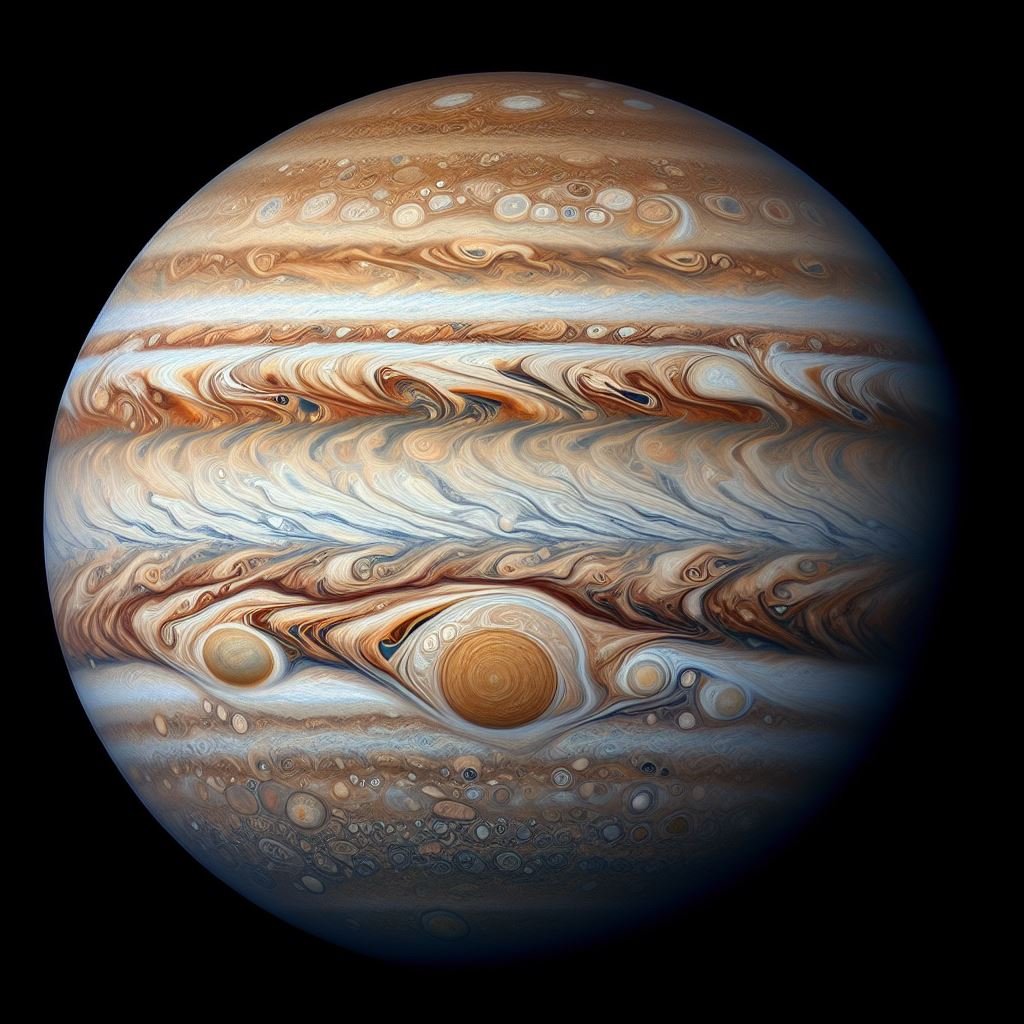

The planet Jupiter; Features, moons, wonders, and everything you need to know
The planet Jupiter, known by other names such as Hormuz, Hormuz, or Jupiter, is the fifth and largest planet in the solar system. Jupiter has played a major role in the evolution of the history of the solar system and it can be said that the earth owes its survival to Jupiter.
This planet is one of the gas giants along with Saturn. The other two planets Uranus and Neptune are in the category of ice giants of the solar system. Jupiter is a mixture of hydrogen and helium, and due to its high rotation speed, its shape is not perfectly spherical. Jupiter’s outer atmosphere is divided into several bands with different latitudes, at the meeting points of these atmospheric bands, storms and eddy currents arise. One of the common points of these strips is the famous big red spot; A huge storm that was first observed with a telescope in the 17th century.
Jupiter has a faint ring and a strong magnetosphere. This planet, also called the king of planets, has 79 confirmed moons. In terms of the number of moons, Jupiter ranks second in the solar system after Saturn (with 82 moons). The most famous moons of this planet are a set of four known as the Galilean moons, which were discovered in 1610 by the Italian scientist Galileo Galilei. Ganymede is the largest moon of Jupiter and the largest moon in the entire solar system.
Robotic spacecraft have done a lot of research on Jupiter. Among the most famous Jupiter missions, we can mention the Voyager and Pioneer missions and then the Galileo orbiter. In late February 2007, the New Horizons probe visited Jupiter and used the planet’s gravity to increase its speed and get in the path of Pluto. The last mission to Jupiter was carried out by the Juno probe, which entered the orbit of the planet on July 4, 2016.
-
Ten interesting facts about the planet Jupiter
-
What does the planet Jupiter symbolize?
-
How was Jupiter formed?
-
Disk instability model
-
Gravel accumulation
-
Customer relocation
-
Jupiter is how much bigger than Earth?
-
Physical characteristics and internal composition of the planet Jupiter
-
Jupiter’s atmosphere and cloud layers
-
Jupiter’s Great Red Spot
-
Jupiter’s magnetic field
-
Rotation and orbit of Jupiter
-
How many moons does Jupiter have?
-
group of moons
-
Irregular moons of Jupiter
-
Galilean moons
-
Moon Io
-
Callisto’s moon
-
Ganymede’s moon
-
Europa’s moon
-
Customer rings
-
Wonders of Jupiter
-
Seeing Jupiter from Earth
-
Pre-telescopic researches
-
Ground-based telescopic research
-
Radiotelescopic researches
-
Jupiter probes
-
Pioneer 10 and 11 (Pioneer)
-
Voyager 1 and 2
-
Galileo Spacecraft
-
Cassini spacecraft
-
Ulysses spacecraft
-
New Horizons spacecraft
-
Juno spacecraft
-
Images by James Webb of Jupiter
-
Future missions to the client
-
common questions
Ten interesting facts about the planet Jupiter
1. Jupiter is the largest planet in the solar system, which is named after the god of the sky and thunder. This planet is mainly composed of gas (hydrogen and helium) and its inner core is almost the same size as Earth.
2. The planet Jupiter has at least 79 moons, of which the four big red ones are: Io, Europa, Ganymede and Callisto (these moons are also known as Galilean moons in honor of Galileo). Although Jupiter cannot host life, some of its moons have the potential for life due to the existence of subsurface oceans.
3. Jupiter rotates around itself faster than any other planet, and this causes streaks: dark areas (belts) represent rising clouds and gases; Bright areas (areas) indicate belt subsidence.
4. Jupiter’s rotation speed is fast at the equator and slow at the poles; Thus, the gas layers in the impact areas cause white spots, spiral storms, and vortices. One of Jupiter’s most famous storms is the Great Red Spot, three times the size of Earth. This is not a permanent storm.
5. Jupiter has four rings. The Voyager 1 probe discovered these rings in 1979. These rings are very faint and were made of dust particles, unlike Saturn’s transparent rings, which are composed of ice and rock.
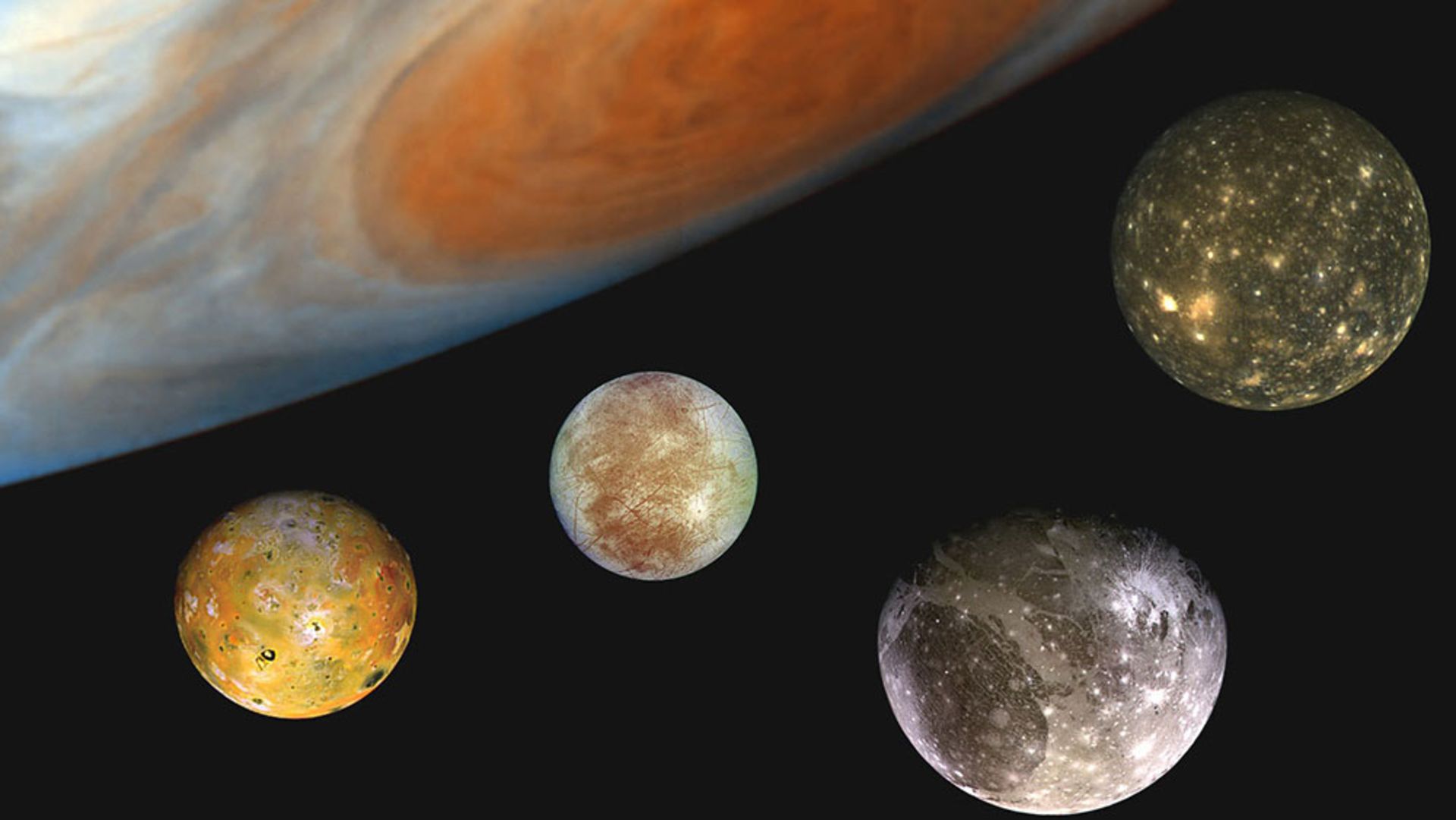
(from top to bottom): Jupiter’s Great Red Spot, Io, Europa, Ganymede, Callisto
During its mission, the Juno probe has also reached interesting facts about the planet Jupiter, which we mention:
6. Jupiter’s atmosphere is amazing. According to Juno’s findings, this gas giant is much more turbulent than expected. Cloudy and windy weather is not seen only in the upper layer of this planet. Rather, these winds exist thousands of kilometers deep in Jupiter. Also, surprisingly, Jupiter’s bands disappear near its poles.
7. According to the hypotheses, Jupiter’s famous gas clouds (a mixture of water and ammonia) are equally mixed. However, there is less ammonia on the surface and more ammonia is concentrated in the core.
8. At Jupiter’s north and south poles, circular chains of massive tornadoes are flowing. These rotating storms are very dense in the dimensions of the continents of the earth. Their length reaches 48 kilometers and their width reaches hundreds of kilometers.
9. Jupiter’s solid core is not fully compressed at its center. Rather, it is an inflated sphere in the dimensions of half the diameter of Jupiter. No one knows what is the reason for this problem, but according to the hypotheses, a heavy mass collided with Jupiter, which caused its core to combine with other surrounding gases.
10. Jupiter has the strongest magnetic field in the Solar System, but Juno shows it’s even stronger than expected, closer to the planet’s surface. Also, Jupiter’s north and south poles are not the same.
What does the planet Jupiter symbolize?
The planet Jupiter has been known since ancient times. This planet is also known by many names in different cultures such as Jupiter (Roman culture), Burgess, Urmazd, and Zavash. Jupiter can be seen in the night sky with the naked eye and sometimes during the day (when the sunlight is low). The Romans named this planet after one of the gods of Roman mythology, Jupiter (also known as the god of love).
The Babylonians knew Jupiter by the name of their god, Marduk. They used Jupiter’s 12-year period next to the ecliptic to define the zodiac constellations. The Romans considered Jupiter a star. On the other hand, in Greece, Jupiter was known as Zeus (the equivalent of the Roman god Jupiter). The ancient Greeks knew this planet as Phaeton, which means shining or burning star. The origin of the astrological symbol of Jupiter (image below) is not known, But many consider it to be a symbol of lightning, and according to new reports, this symbol is based on the Egyptian hieroglyphic script that means eagle.

How was Jupiter formed?
It has been nearly 13.8 billion years since the Big Bang and the beginning of the universe, and almost 4.6 billion years since the formation of the solar system. Jupiter is the oldest planet in the solar system. This planet, which is 2.5 times heavier than the rest of the planets in the solar system, has played an important role in the formation and evolution of its neighbors. 4.6 billion years ago, the solar system was a cloud of gas and dust or the solar nebula. Gravity caused this material to collapse and begin to rotate; The sun was born in its center. As the sun formed, the rest of the material condensed. Small particles were brought close to each other by the force of gravity and turned into larger particles.
The solar wind blew away lighter elements like hydrogen and helium, and heavier rocky material near the Sun formed smaller rocky worlds like Earth. Since the solar wind had less effect on the lighter elements, these elements joined together to form gas giants.
According to the core accretion model, the rocky cores of the planets were formed first, then the lighter elements formed the mantle and the crust of the planets. On rocky worlds, the lighter elements formed the atmosphere. Examination of exoplanets (outside the solar system) supports the core accretion theory as the dominant formation process. Stars with more metal in their cores (a term astronomers use for elements other than hydrogen and helium) have larger planets in their systems than stars made only of metal.
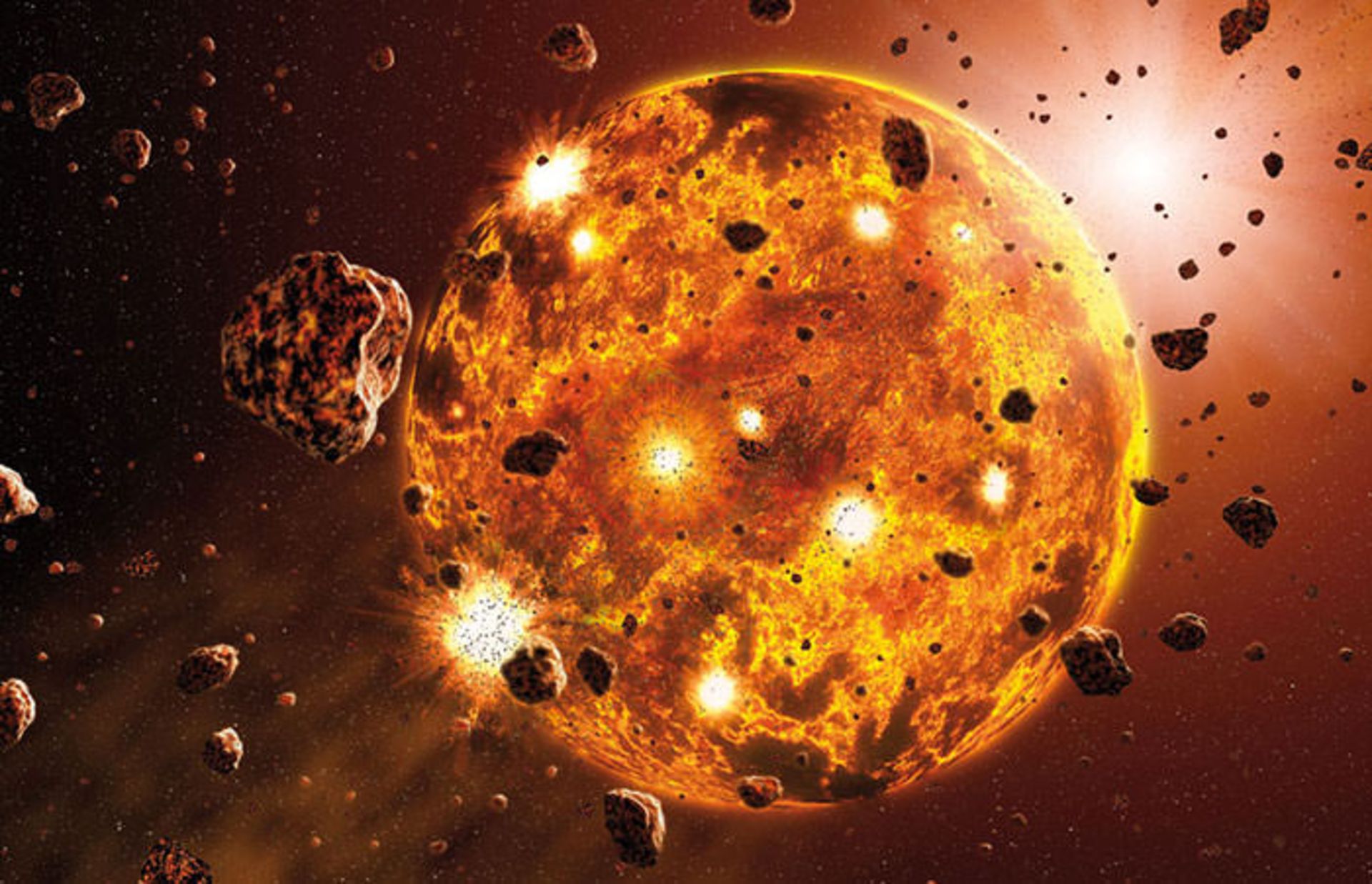
Disk instability model
The core accretion process for gas giants like Jupiter takes a long time. The cloud of matter around the sun lasts only a short time; It either becomes a planet or disappears completely. Giant planets, unlike rocky planets such as Mars and Earth, formed very quickly and only in a few million years. As a result, based on a certain period of time, the gas ring around the sun lasted only 4 to 5 million years.
According to a relatively new theory called disc instability, masses of gas and dust joined together early in the life of the solar system. Over time, these masses turned into larger planets. The speed of formation of these planets based on this theory is faster than the core accumulation theory and sometimes even reaches several thousand years. Constant collisions in Jupiter (just like other planets) raised the temperature of this planet. Dense material moved towards the center and formed the nucleus. Some scientists believe that the core of this planet can be a hot ball of liquid; While according to other researchers, Jupiter’s core is a solid rock with a size of 14 to 18 times that of Earth.
Gravel accumulation
The biggest challenge of nuclear accretion theory is its time. According to another study, small pebble-sized objects joined together to form large planets at a rate 1,000 times faster than previous models. In 2012, two researchers named Michel Lambrecht and Anders Johansen from Lund University in Sweden presented the theory of small particles. Based on their analysis, pebbles left over from formation processes (which were previously considered insignificant) could hold the key to the problem of planet formation.
Customer relocation
In 2011, scientists unveiled the Grand Tack model. According to this theory, the customer had a two-stage migration after forming. Jupiter was formed exactly at a distance of 3.5 AU from the Sun, and after a two-stage transition, it is at its current position of 5.2 AU.
Jupiter is thought to have destroyed many objects during these transits, including some of the first-generation planets of the solar system. Without Jupiter, there would probably be no Earth; This planet has cleared the way for Earth by destroying smaller worlds.
Jupiter is how much bigger than Earth?
If we add the mass of all the planets of the solar system together, the mass of Jupiter will be more than twice that. This gas giant can accommodate 1300 planets. As a result, if you consider the planet Jupiter to be the size of a basketball, the Earth will be the size of a grape seed. This gas planet is also 318 times heavier than Earth. In the diameter of Jupiter, you can fit 11 planets.
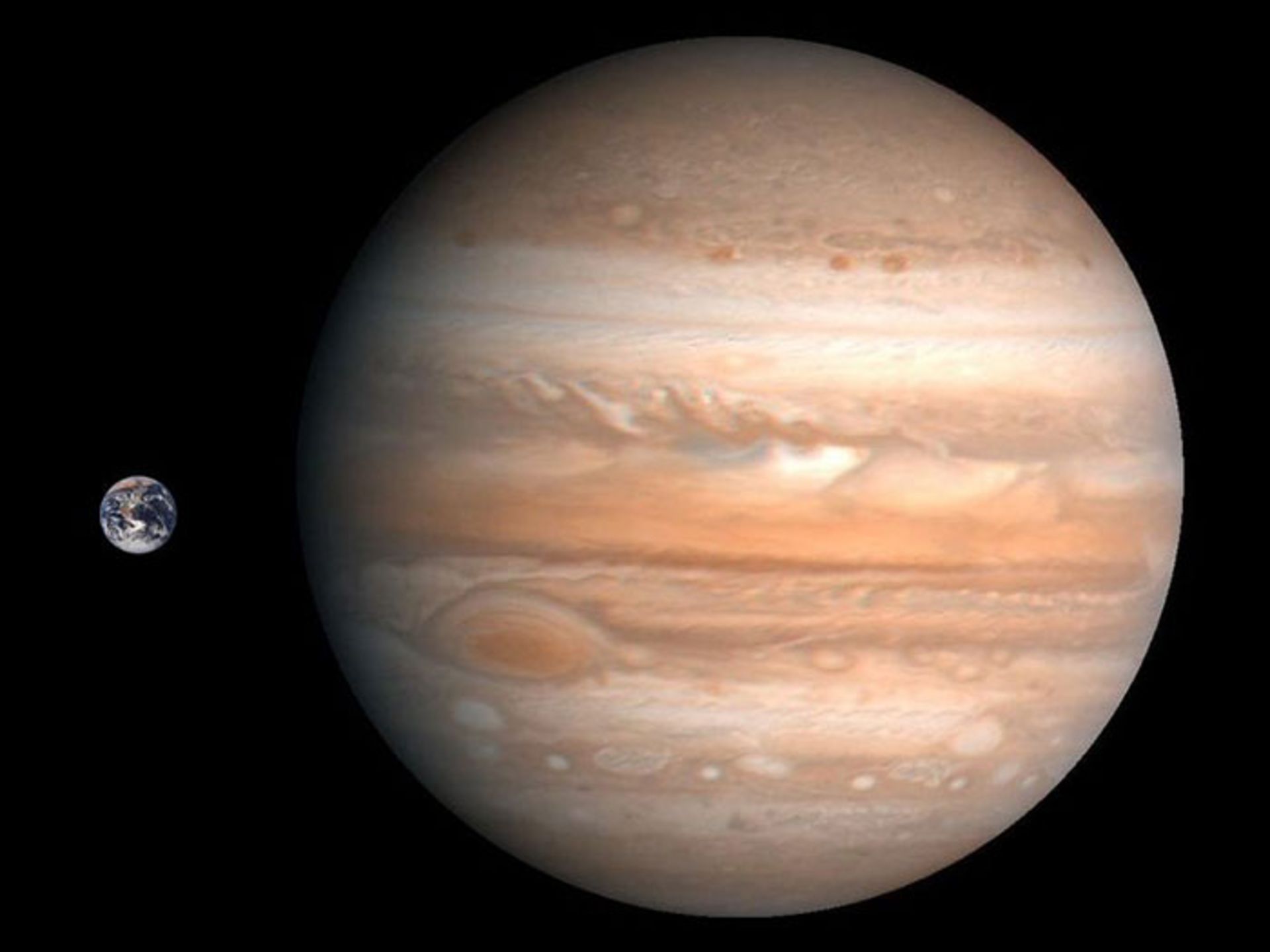
Planet Earth against Jupiter; Jupiter contains more than 1300 lands
Physical characteristics and internal composition of the planet Jupiter
A large part of Jupiter consists of liquid and gaseous materials. The diameter of this gas giant reaches 142,984 km. Its average density is 1326 grams per cubic centimeter, and in this respect, it ranks second among gas giants. A large part of Jupiter consists of gaseous and liquid materials, and denser materials are located in the lower layer. 88-92% of the upper atmosphere of this planet is made up of hydrogen and 8-12% of it is made up of helium. Generally, 75% of the mass of this planet is hydrogen, 24% is helium and the remaining 1% are other elements.
Jupiter’s atmosphere contains amounts of methane, water, steam, ammonia, and silicon compounds. Traces of carbon, ethane, hydrogen sulfide, neon, oxygen, phosphine, and sulfur can also be seen in it. The outermost layer of the atmosphere consists of frozen crystals of ammonia. The material density is higher in the inner layers. The discovery of water on the planet Jupiter was one of the interesting discoveries of the past years. Using the Juno probe, scientists have found evidence of water on the planet Jupiter, which is far beyond their imagination.
Using ultraviolet and infrared measurements, amounts of benzene and hydrocarbons have also been discovered on this planet. According to the spectroscopic results, the composition of Jupiter is almost the same as that of Saturn; But the other two gas giants, Uranus and Neptune, have less hydrogen and helium and more ice than Jupiter, and hence they are also called ice giants.
Jupiter can hold 1,300 Earths
Based on gravity measurements in 1977, the mass of the core of this planet was estimated to be 12 to 45 times greater than the mass of Earth. Jupiter’s core makes up 4-14% of its total mass. The radius of Jupiter is approximately one-tenth of the radius of the Sun and the mass is one-thousandth of the mass of the Sun; Therefore, the density of both is the same. Jupiter’s mass is commonly used as a unit to describe the mass of other objects, especially exoplanets or brown dwarfs.
If Jupiter were 75 times heavier, it would have the possibility of hydrogen fusion and become a star; Meanwhile, the radius of the smallest red dwarf is only 3% more than Jupiter. However, Jupiter emits more heat than it receives from the sun.
The amount of heat produced by Jupiter is equal to the total solar radiation received by this planet. This process causes Jupiter to become smaller by 2 cm every year. While it was much hotter at the beginning of its formation its diameter was twice its current diameter. According to existing hypotheses, the core of Jupiter is rocky; But its exact composition is still unknown. The core may be surrounded by dense metallic hydrogen, which makes up 78% of the planet’s radius. Raindrops such as helium and neon are deposited towards the bottom of this layer and the abundance of these elements in the upper atmosphere is minimized.
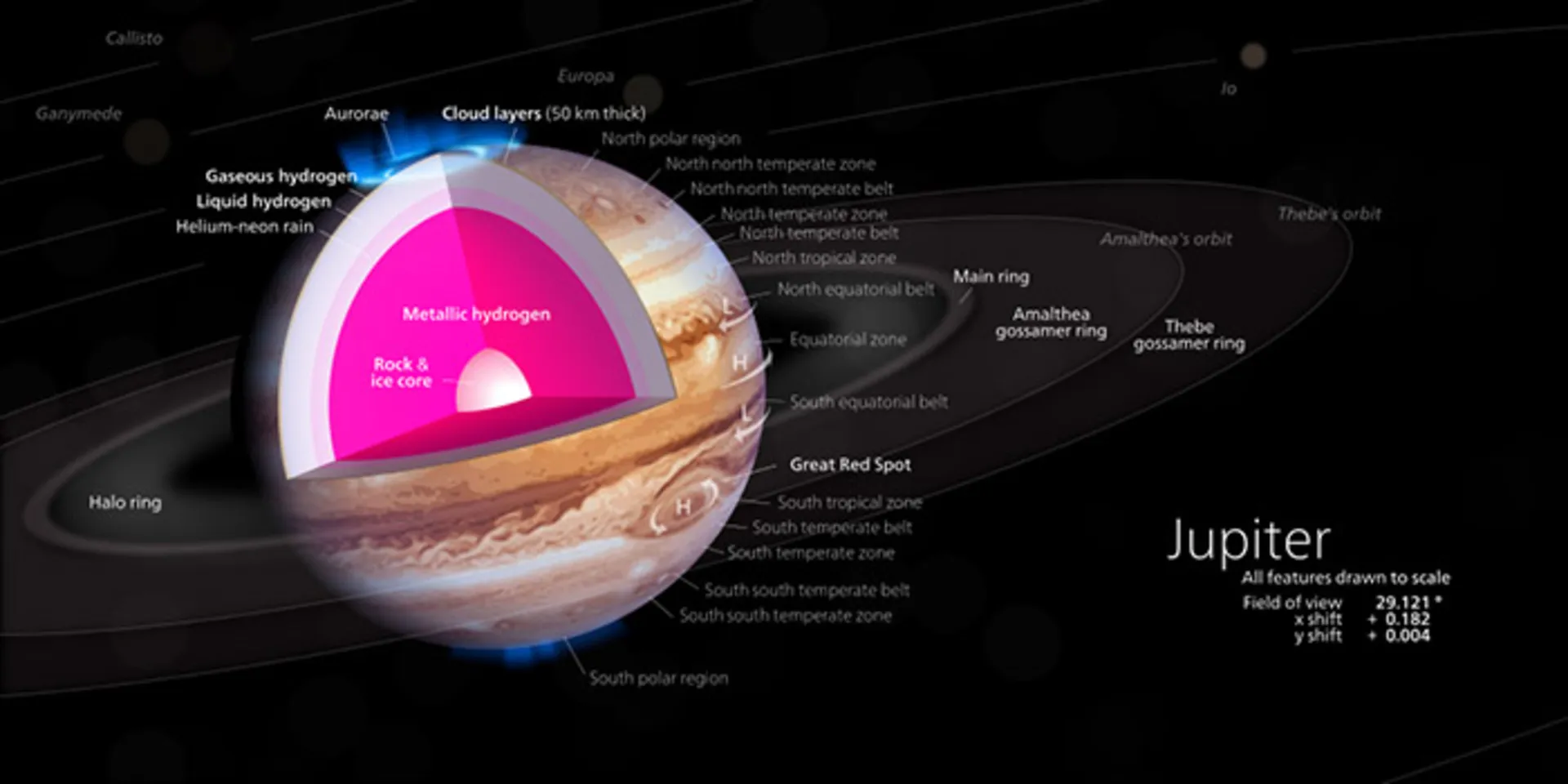
This cut shows a model of Jupiter’s interior with a rocky core surrounded by a deep layer of liquid metallic hydrogen.
Jupiter’s atmosphere and cloud layers
Like the Sun’s atmosphere, most of Jupiter’s atmosphere consists of hydrogen and helium. The dark and light-colored bands on Jupiter’s atmosphere are caused by strong east-west winds that move at a speed of more than 539 kilometers per hour. Clouds in bright areas are composed of frozen crystals of ammonia; While clouds in darker areas are made up of other chemicals. In the deepest observable level of this planet, there are blue clouds. Jupiter’s cloud bands change over time and rain diamonds within Jupiter’s atmosphere.
It is hard to say what exactly Jupiter’s atmosphere is made of because 90% of this planet is hydrogen and 10% is helium. On Earth, all these gases are considered atmospheric; But the strong gravity of Jupiter causes the atmosphere of this planet to become several separate layers, each of which has attractive and unique characteristics. Unlike Earth, there is no clear boundary between Jupiter’s atmosphere and the planet itself. By penetrating further into the depths of Jupiter, the density and temperature of hydrogen and helium change, and based on these changes, scientists describe the different layers of Jupiter’s atmosphere. Jupiter’s atmospheric layers include the troposphere, stratosphere, thermosphere, and exosphere.
Since Jupiter does not have a solid surface, scientists estimate the pressure of the lower part of its atmosphere to be 100 kilopascals; The planet’s atmosphere is defined just above this point. Like Earth’s, Jupiter’s atmosphere decreases with altitude until it reaches its minimum value. The minimum amount of atmosphere can be found at the boundary between the troposphere and stratosphere, the tropopause (approximately 50 km above the surface of Jupiter).
The stratosphere extends up to a height of 320 km, and along that line, the pressure decreases, as the pressure decreases, the temperature increases. At this point, the boundary between the stratosphere and the thermosphere is defined. The temperature of the thermosphere reaches 726 degrees Celsius at an altitude of 1000 kilometers. All visible clouds and storms are located in the lower troposphere of Jupiter and are composed of ammonia, hydrogen sulfide, and water.
Jupiter’s Great Red Spot
The most obvious feature of Jupiter is its big red spot. This spot is a persistent larger-than-Earth cyclonic storm located at an angle of 22 degrees to the equator, which was discovered based on one hypothesis from 1831 and another from 1665. This spot is large enough to be easily seen with an amateur telescope with an aperture of 12 cm. The rotation direction of this tornado is anti-clockwise and its circulation period is 6 days. The maximum height of this storm is 8 km above the cloud area.
According to mathematical models, this storm is stable and may be one of the stable features of this planet. However, the size of this spot has always decreased. In the late 1800s, the width of this spot was estimated to be about 56,327 km, which is four times the diameter of the earth. After the Voyager 2 spacecraft reached this planet in 1979, the diameter of this storm had decreased to twice the width of the planet Earth.
Reviews of Jupiter’s red spot show that the spot is still shrinking in size. On April 3, 2017, the width of this spot was estimated to be 16,350 km, which is 1.3 times the diameter of the Earth. Earth’s longest storm lasts 31 days, But Jupiter has more stable storms due to having thousands of kilometers of atmosphere at a speed much faster than the Earth’s rotation.

Jupiter’s Great Red Spot has shrunk over the years.
Jupiter’s magnetic field
Jupiter’s magnetic field is fourteen times stronger than Earth’s magnetic field. This field is thought to be created by eddy currents in the metallic hydrogen core of this planet. Some features of Jupiter’s magnetic field are unique and do not exist in Earth’s magnetic field.
The volcanoes of Jupiter’s moon Ivy release large amounts of sulfur dioxide, resulting in a gas halo around the moon’s orbit. This gas is ionized in Jupiter’s magnetosphere and sulfur and oxygen ions are released.
These ions together with the hydrogen ion of Jupiter’s atmosphere form a plasma sheet in the equatorial body of this planet. The plasma in this sheet rotates with the planet and leads to the change of the bipolar magnetic field into a magnetic disk. The electrons in the plasma sheet create a strong radio effect that produces bursts in the 0.6 to 30 MHz range.
Jupiter’s magnetosphere is responsible for the intense emission of radio material from the polar regions of this planet. Volcanic activities of this planet’s moon Ivy lead to the release of gas in Jupiter’s magnetosphere and create a halo of particles around it. As Io moves in this halo, Alphon waves are created. An Alfón wave is a type of magnetohydrodynamic wave in which ions oscillate along magnetic field lines in response to an effective voltage. These waves carry ionic material in Jupiter’s polar regions.
Rotation and orbit of Jupiter
The average distance between Jupiter and the Sun is 778 million kilometers (about 5.2 times greater than the distance between the Earth and the Sun) and the Earth orbits the Sun every 11.86 years. Compared to Earth, Jupiter’s elliptical orbit has a deviation of 1.31 degrees. The eccentricity of this planet’s orbit is 0.048, which is why its distance from the Sun varies between the closest contact (perigee) and the farthest distance (apex) as much as 75 million kilometers.
The axial tilt of this planet is relatively small: 3.13 degrees. As a result, it does not have many seasonal changes compared to Earth and Mars. Jupiter rotates the fastest among the planets of the solar system and completes its rotation around its axis in less than ten hours. Due to the high speed of rotation, an equatorial bulge is created, which is easily visible through an amateur telescope located on Earth. The diameter of Jupiter’s equator is 9275 km more than the diameter of its poles. Because Jupiter is not a solid body, its upper atmosphere has a different rotation. Jupiter’s polar atmosphere rotates approximately 5 minutes longer than its equatorial atmosphere.
How many moons does Jupiter have?
Jupiter has 79 confirmed moons. In terms of the number of moons, Jupiter ranks second in the solar system after Saturn (with 82 moons); But according to the latest research, Canadian astronomers found evidence of the existence of 45 small moons in the orbit of Jupiter, and based on speculations, the number of moons of this planet can reach 600; But they have not yet reached the verification and monitoring stage.
Overall, among Jupiter’s 79 confirmed moons, the four largest Galilean moons are the most prominent. These moons were discovered independently by Galileo Galilei and Simon Marinus in 1610. As early as 1892, more moons of Jupiter were discovered and named after the lovers or daughters of Jupiter, the Roman god, or Zeus (his Greek counterpart). The Galilean moons are the largest and heaviest objects in Jupiter’s orbit.
Jupiter’s eight moons are regular moons with nearly circular orbits. The Galilean moons are nearly spherical due to their planetary mass. If these moons were in the orbit of the sun, they would be classified as dwarf planets. The other four moons are smaller and less distant from Jupiter; These moons are sources for the formation of Jupiter’s rings. Other moons of Jupiter are irregular and their orbits are further away from Jupiter. These moons are probably trapped by Jupiter’s gravity from the solar orbits. Jupiter’s twenty-two irregular moons have yet to be officially named.
Jupiter’s regular moons are thought to have formed from the planet’s rotating disk; A ring of gas and rock similar to a primordial planetary disk. On the other hand, irregular moons are composed of asteroids that are caught in the trap of Jupiter’s gravity. According to many scientists, these asteroids were crushed and then formed the irregular moons of Jupiter due to impact with other small bodies.
Group of moons
In general, Jupiter’s moons are divided into two categories: regular and irregular. Irregular moons are divided into two groups: internal moons (Amaltia) and Galilean moons.
- Internal moons (Amaltia): Metis, Adrastia, Amaltia, and Thebe are internal moons of Jupiter; Because they are in close proximity to this planet. Two of the innermost moons complete the orbit of Jupiter in less than a day. The other two moons are the fifth and seventh largest moons in Jupiter’s lunar system, respectively. According to observations, at least the largest member of this group, Amaltia, did not form on the current orbit, but was already further away from Jupiter.
- The main group of Galilean moons: Io, Europa, Ganymede, and Callisto are among the largest moons in the solar system in terms of mass and size. The diameter of the moon Ganymede is even greater than the planet Mercury, but its mass is less. These moons are the fourth (Io), sixth (Europa), first (Ganymede), and third (Callisto) natural moons of the solar system, respectively, and comprise approximately 99.997% of the total mass of Jupiter’s orbit. Jupiter is 5000 times heavier than its moons.
Irregular moons of Jupiter
Irregular moons of Jupiter are small bodies with eccentric orbits and further away from Jupiter. These moons have similarities such as declination, eccentricity, semimajor axis, and chemical composition. According to scientists, these are a group of impact moons that were formed by the collision of larger parent objects with asteroids caught in Jupiter’s gravitational field.
Galilean moons
The Galilean moons are among the most well-known moons of Jupiter that have been studied by various probes and more information is available. In the following, we mention the features and explorations related to these moons.
Moon Io
Io is the fifth largest moon of Jupiter and has the most volcanic activity in the solar system. This moon has sulfur channels that spread up to 300 km. Io’s surface is filled with lava seas and liquid rock floodplains. Astronomers discovered a map of 150 volcanoes on this moon, some of which emit lava up to 400 kilometers into space. At 4.5 billion years old, Io is the same age as its host planet Jupiter. The average orbital distance between Io and Jupiter is 442 thousand km. It takes 1.77 Earth days for Io to complete an orbit around Jupiter. Io has a tidal lock and always has one side facing Jupiter. The diameter of Io is approximately 1,820 km, which is slightly more than the diameter of the Moon.
Io is the only moon in the solar system with active volcanoes
Io has a relatively oval shape. Among the Galilean moons, Io ranks lower than Ganymede and Callisto in terms of mass and volume and ranks higher than Europa. The average surface temperature of Io is minus 130 degrees Celsius. For this reason, sulfur dioxide snow bodies are abundant on its surface. Io is also called the moon of ice and fire.
Io was discovered on January 8, 1610, by Galileo Galilei. He actually discovered this moon the day before, But he could not distinguish Io and Europa. Galileo’s discovery was the first lunar discovery at that time. Galileo’s discoveries proved that the planets revolve around the sun, not the earth. Galileo initially named this moon Jupiter 1; But in the middle of the 19th century, its name was changed to Ayo. In Greek mythology, Io was the priestess of Hera (wife of Zeus) and the daughter of Inachus, king of Argos. Zeus (the Greek counterpart of the Roman god Jupiter) fell in love with Io, But he turned him into a cow to protect him from his wife Hera.
IO features: IO’s interior consists of an iron sulfide core and a brown silicate outer layer. This combination has given this moon a mottled appearance with orange, black, yellow, red, and white colors. Based on data obtained from computer models, Io formed in a region around Jupiter where the abundance of ice was initially high. The heat of Io along with the water on its surface shortly after its formation can be a sign of the existence of ancient life; Even in an environment where Jupiter’s radiation destroys surface water.
The most prominent features of this moon are its volcanoes. After Earth, Io is the only body in the solar system with active volcanoes. Galileo made notes of volcanic activity, and NASA’s Voyager spacecraft confirmed Io’s volcanoes in 1979. Due to volcanic activity, a large part of the atmosphere is sulfur dioxide. Based on observations from the Gemini North telescope in Hawaii and the TEXES spectrometer in 2018, Io’s atmosphere is likely to collapse. Io’s sulfur dioxide gas mantle freezes in shadow every day. When Io returns to sunlight, the frozen sulfur dioxide turns into a gas once more.

Callisto’s moon
Callisto is one of the large moons in the orbit of Jupiter. This moon has an ancient surface full of impact craters, which shows that there is no news of geological processes in it; But this moon has an underground ocean and because of its old surface, the existence of life in this ocean is still not certain.
Callisto, like the other four Galilean moons, was discovered in 1610. The name of this moon was originally Jupiter IV, But in the 19th century, it was called Callisto. Callisto was studied by several probes, including the long-duration mission of the Galileo spacecraft to Jupiter in the 1990s and 2000s. The Juno spacecraft has also recorded remote images of the moon Callisto. At 4.5 billion years, Callisto is the same age as its host planet, Jupiter. This moon is the heaviest body with an impact hole in the entire solar system, But its surface has remained untouched since almost 4 billion years ago.
Among the Galilean moons, Callisto is the outermost. This moon is located at a distance of one million eight hundred and eighty thousand kilometers from Jupiter. Callisto takes approximately seven Earth days to complete an orbit of Jupiter. Callisto has fewer tidal effects than the other Galilean moons; Because on the other side of Jupiter’s main radiation belt is located. Callisto is tidally locked to Jupiter and always faces Jupiter on one side.
With a diameter of 4800 km, Callisto is almost the same size as the planet Mercury. This moon is the third largest moon in the solar system after Ganymede and Titan (Saturn’s moon). Moon is placed in fifth place after Io. Callisto’s surface temperature reaches minus 139.2 degrees Celsius. In 1996, the Galileo spacecraft sent back detailed information about Callisto. The mission mapped much of the moon’s surface and discovered its thin carbon dioxide atmosphere and evidence of a subsurface ocean. Callisto’s effect on the auroral bursts of Jupiter’s atmosphere has been revealed based on a review of images obtained from the Hubble Space Telescope in 2018. The client himself has an aura, But some of Jupiter’s aurora phenomena originate from interactions with its four large moons.
Future missions, including JUICE, which will investigate Jupiter’s icy moons, will reveal more about Callisto and the possibility of life there. Papers have also been published on modeling the interaction of Jupiter’s magnetic field with Callisto (this review provides evidence for Callisto’s subsurface ocean) and finding atomic oxygen in the moon’s atmosphere. Other papers have focused on dimensions such as subsurface water, the number of impact craters, and atmospheric properties.
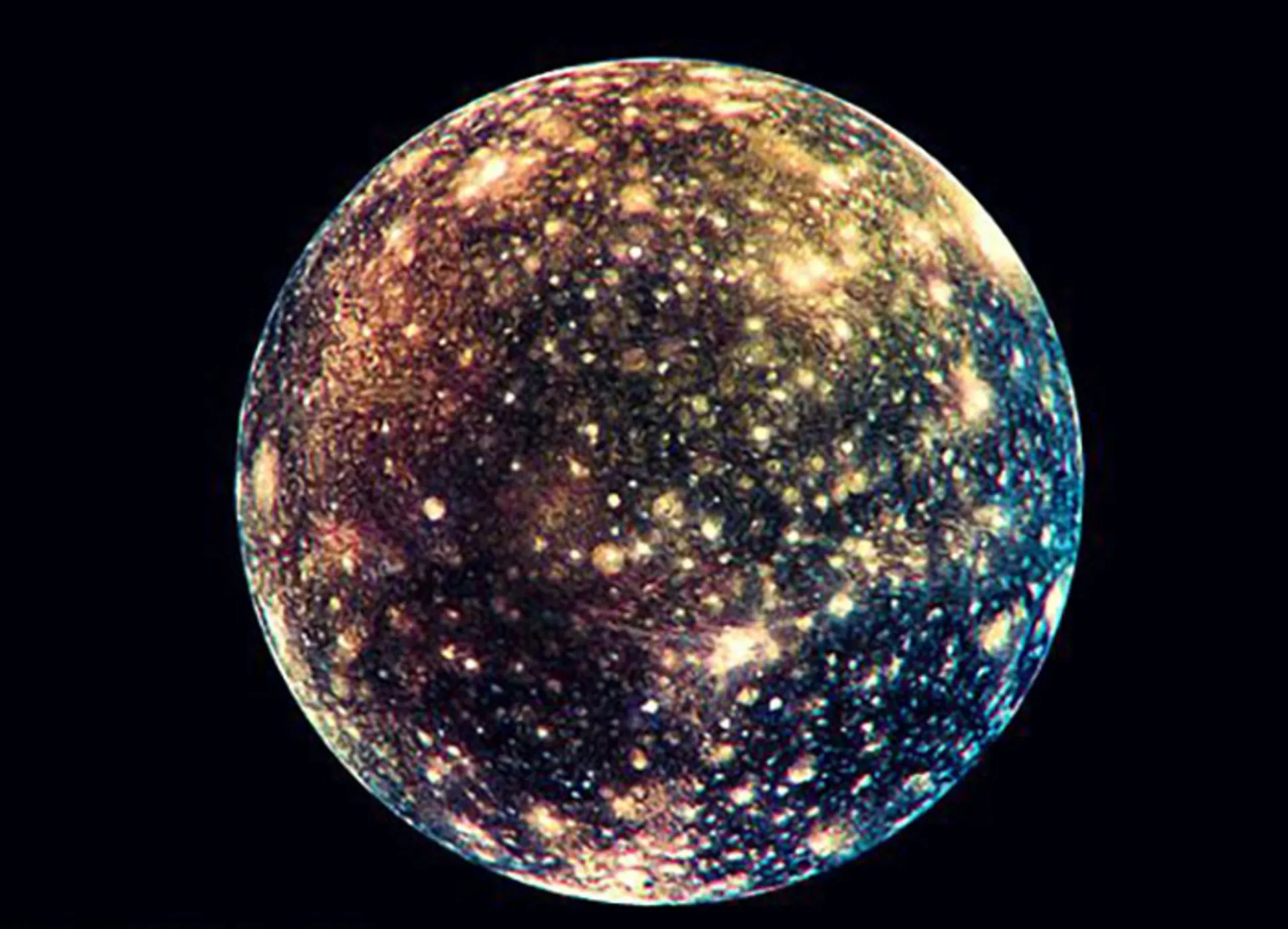
Ganymede’s moon
Ganymede is the largest moon of Jupiter and the largest moon in the entire solar system. This moon is even bigger than Mercury and Pluto and slightly smaller than Mars; As a result, if it was in the orbit of the sun, it would easily be classified as a planet. Ganymede probably has a saltwater ocean beneath its icy surface; As a result, it becomes one of the strong candidates for life discoveries. Ganymede is one of the targets of the JUICE mission, which will be launched in the 2030s.
The three moons of Callisto, Ganymede, and Europa have subsurface oceans of saltwater
Like Callisto and Io, Ganymede is the same age as Jupiter at 4.5 billion years old. This moon is more than one million and seventy thousand kilometers away from Jupiter and completes the orbit of this planet in seven days. The average radius of Ganymede is 2631.2 km. Ganymede is larger than Mercury, but its mass is half that of Mercury, and as a result, it has a low density. The average daytime temperature on the surface of Ganymede reaches minus 113 to minus 183 degrees Celsius. Astronomers with the Hubble telescope found evidence of Ganymede’s thin oxygen atmosphere in 1996. However, this atmosphere is too thin to support life as we know it, and it is unlikely that life could inhabit Ganymede.
Ganymede is the only moon with a magnetosphere in the entire solar system. A magnetosphere, commonly seen on planets like Jupiter and Earth, is a comet-shaped region where charged particles are trapped and deflected. Ganymede’s magnetosphere is embedded in Jupiter’s magnetosphere. After Galileo discovered Ganymede, he renamed it Jupiter III. With the increase in the number of objects discovered in the middle of the 19th century, the name of this moon was changed to Ganymede based on Greek mythology.
Features of Ganymede: Ganymede has an iron core, a rocky mantle, and a very thick crust, most of which is made up of ice. Also, traces of rock formation can be seen on the surface of Ganymede. In February 2014, NASA unveiled a detailed map of Ganymede in the form of images and video animation, created using observations from NASA’s Voyager 1 and 2 spacecraft as well as the Galileo orbiter.
Ganymede’s surface consists of two main surface types: approximately 40% of Ganymede’s surface is dark with numerous impact craters, and 60% is light-colored with grooves that give Ganymede its distinctive appearance. Grooves are caused by tectonic activities or subsurface water release.
According to scientists, Ganymede has an underground saltwater ocean. In 2015, scientists used the Hubble Space Telescope to study Ganymede’s auroras and the changes between the magnetic fields of Jupiter and Ganymede. Based on the evidence of these auroras, Ganymede probably has a subsurface ocean of saltwater that is even saltier than Earth’s oceans.
Some scientists have pointed to the possibility of life on Ganymede. Because of Ganymede’s internal structure, the pressure on the ocean floor is so high that any water that reaches it turns into ice. For this reason, hot water currents can hardly deliver nutrients to the oceans.
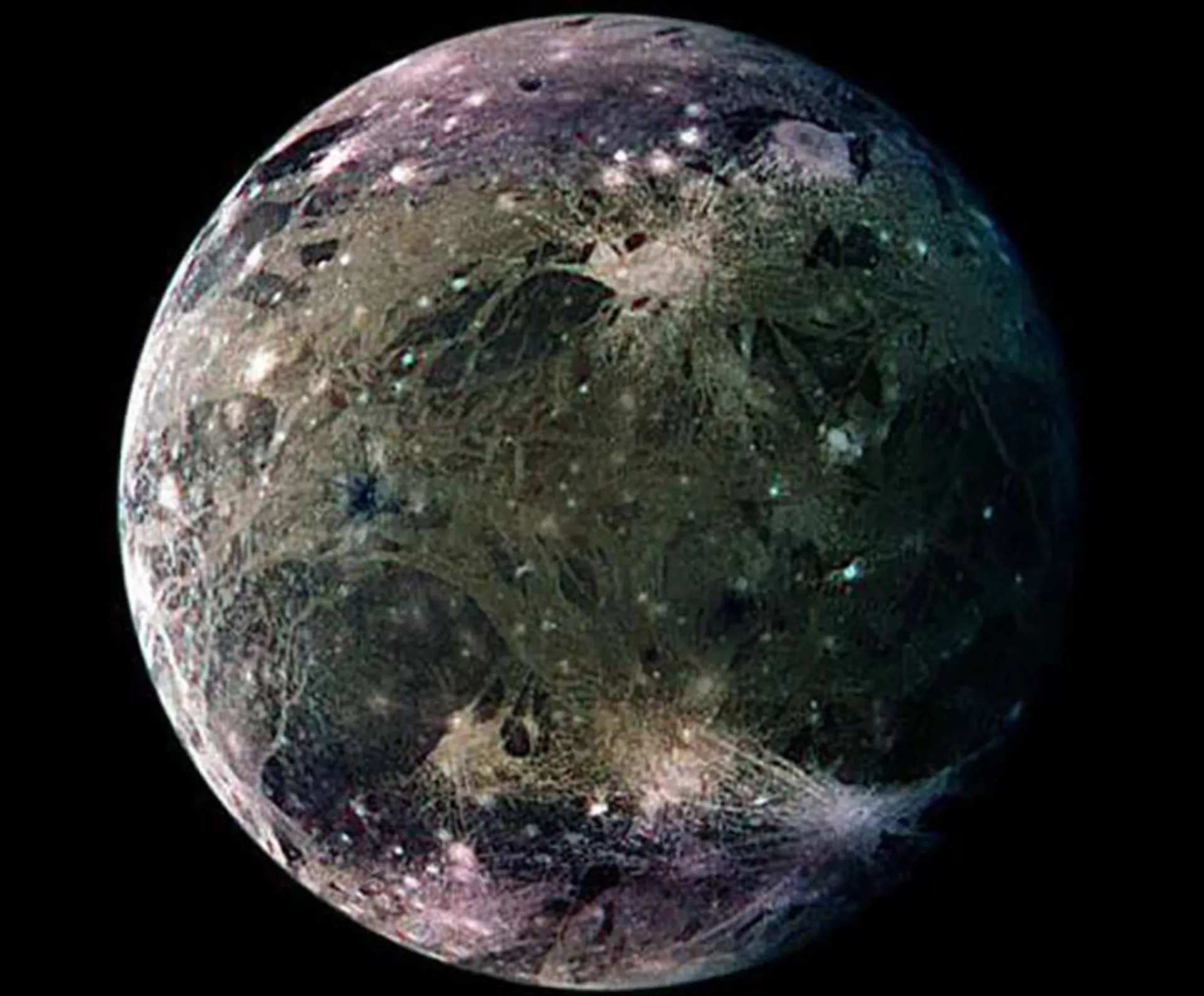
Europa’s moon
Europa is the smallest Galilean moon. The surface of this moon is frozen and covered with a layer of ice; But according to scientists, there is an ocean under this ice surface. The icy surface makes Europa one of the most reflective moons in the solar system.
Using the Hubble Space Telescope, researchers detected signs of geysers from the Antarctic region of Europe in 2012. After several attempts, another research team observed the geysers in 2014 and 2016. Europa’s moon formed at the same time as its host planet, Jupiter, about 4.5 billion years ago. On average, the distance between Europe and Jupiter is 670,900 kilometers. It takes Europa three and a half Earth days to complete an orbit of Jupiter. Europe has a tidal lock to Jupiter; Therefore, one side is always facing the customer.
With a diameter of 3100 km, Europa is smaller than the Moon and larger than Pluto. The temperature of Europe’s surface at the equator never rises above minus 160 degrees Celsius, and at the poles of this moon, it never rises above minus 220 degrees Celsius. Galileo discovered the Europa moon on January 8, 1610. Of course, he had observed it the day before on January 7; But he could not distinguish this moon from Io. In Greek mythology, Europa is stolen by Zeus (a counterpart of Jupiter, the Roman god) and takes the form of a white bull to seduce Europa. He decorates the cow with flowers and sends it to the city of Crete. Zeus returns to his normal form in Crete and seduces Europa. Europa was the queen of Crete and bore Zeus several children.
One of the prominent features of Europa is its high reflectivity due to its ice crust. According to scientists’ estimates, the surface of Europe is 20-180 million years old. Images and data from the Galileo spacecraft show that Europa has a composition of silicate rock, an iron core, and a rocky mantle just like Earth. Unlike the Earth’s interior, Europa’s rocky atmosphere is surrounded by a layer of water or ice, which is 80 to 170 km thick. Based on the fluctuations of Europa’s magnetic field, there is probably an ocean beneath the moon’s surface that could host life. The possibility of extraterrestrial life has made Europa an attractive destination for space exploration.
The surface of Europe is full of cracks and fissures. According to many scientists, these cracks are the result of the tidal forces of the ocean beneath Europa’s surface. As Europa approaches Jupiter, sea levels below the ice rise above normal. In this situation, the continuous tide of the sea causes cracks in the surface of this moon. In 2014, scientists discovered that Europa could host tectonic plates. In the solar system, only the Earth has a variable crust, which is useful for the evolution of life on Earth.
Life in Europa: The presence of water under the frozen crust has made Europa’s moon one of the possible candidates for hosting life in the solar system. The icy depths of this moon probably have channels to the mantle like Earth. These channels provide the warm environment necessary for the evolution of life. According to a 2016 study, Europa’s oxygen content was estimated to be ten times that of hydrogen, similar to that of Earth. Thus, the ocean under the surface of Europe becomes a better environment for life.
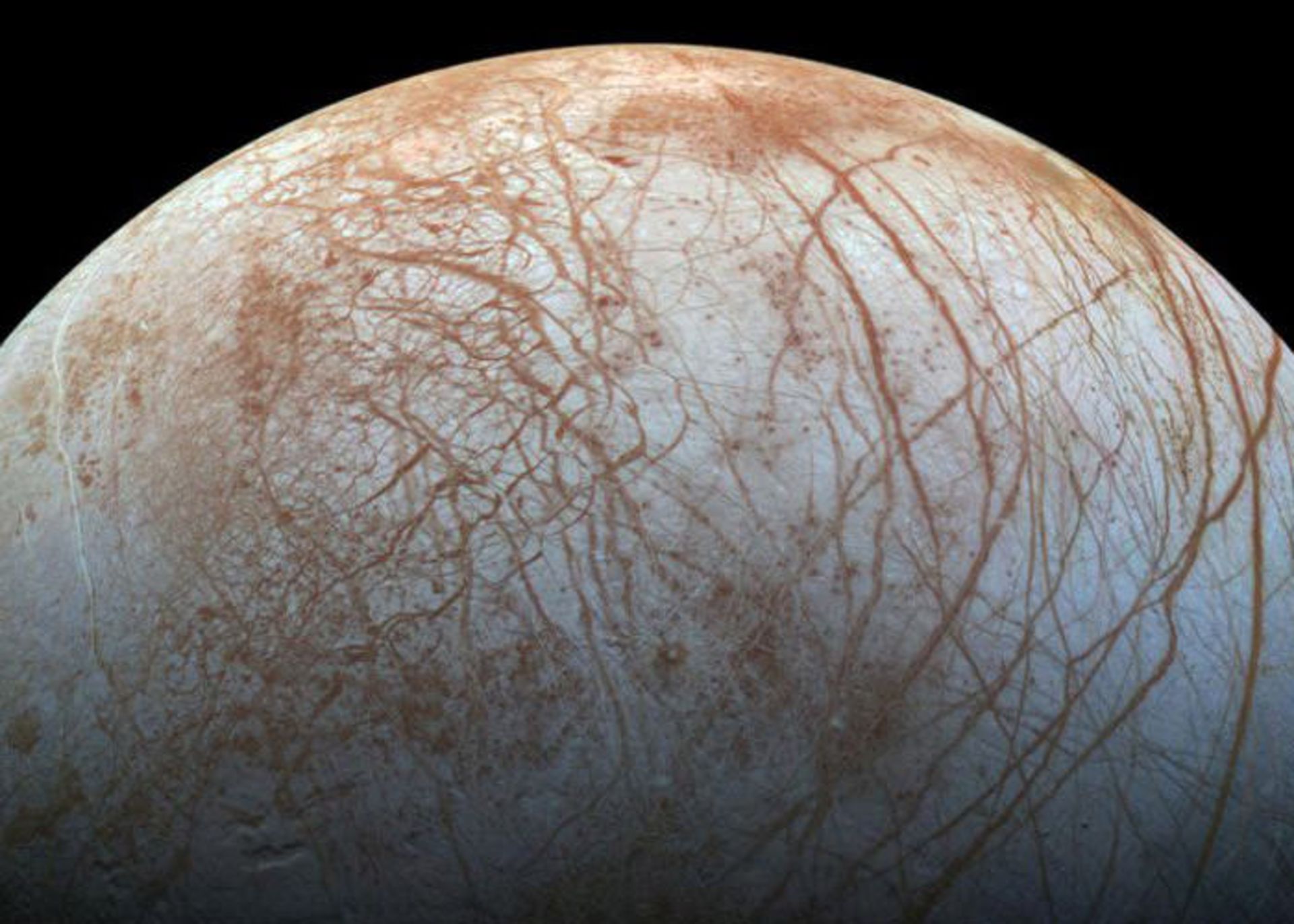
Europa, a moon of Jupiter
Customer rings
Maybe for many people this question has arisen, why the planet Jupiter does not have rings like Saturn? In fact, Jupiter has rings, but since Jupiter’s rings are made of rock and dust, and Saturn’s rings are made of rock and ice, Jupiter’s rings do not appear as bright as Saturn’s rings. Jupiter’s rings are divided into three parts: halo, main ring, and thin ring. Jupiter’s rings were discovered by the Voyager probe in 1980. The composition of Jupiter’s rings is different from that of Saturn, which is composed of ice. Jupiter’s rings are very faint and delicate.
- Halo section: The innermost part of Jupiter’s rings, which is made up of dust and surrounds the space around the planet. This is the brightest and thickest part of Jupiter’s rings.
- The main ring section: The main ring section is the narrowest part and consists of dust and gravel. The age of dust particles in this section reaches 1000 years or even 100 years. This means new dust is formed due to impact with larger rocks.
- Thin Outer Ring (Gossamer): Gossamer is the outermost part of Jupiter’s rings. This part, like the previous two parts, is a combination of dust particles; But the word Gossamer means thin material, which is suitable for this part because of the very small dust particles.
Only the most powerful telescopes are capable of observing Jupiter’s rings. Jupiter’s moons are responsible for the formation of the rings of this planet. The innermost moons, such as Amaltha, Adrasta, and Tibe, were hit by many meteorites, and their dust and rock particles entered Jupiter’s orbit, thus forming the rings of this planet.
Wonders of Jupiter
The planet Jupiter has many surprises due to its strong gravity and magnetic field, as well as its strange moons. Below are some examples of these surprises:
The effect of Jupiter on the solar system: Jupiter is also known as the vacuum cleaner of the solar system due to its strong gravity and internal position of the solar system. This planet experienced the most collisions with comets among the planets of the solar system and thus it is thought to act as a shield for the inner planets of the solar system.
If Shoemaker’s comet Levi 9 collided with Earth, there would be no trace of life left on Earth.
However, based on recent computer simulations, Jupiter has not played a significant role in reducing the bombardment of the inner planets of the solar system, although the debate on this issue is still ongoing. At least it saved the inner planets from a catastrophe called Shoemaker Levi 9. Comet Shoemaker Levi 9 has experienced one of the most exciting endings. Shoemaker Levy’s collision with Jupiter left scars on the planet’s surface that are visible even from Earth. This is the first collision of two internal bodies in the solar system, and the effects of this comet on Jupiter’s atmosphere are spectacular and beyond expectations.
Shoemaker’s comet Levi 9 collided with Jupiter in 1994, and this collision caused a lot of fear among the public because if a similar comet hit the Earth, life on the planet would be completely destroyed.

Effects of comet Shoemaker Levi 9 impact on Jupiter
Two movies, Armageddon and Deep Encounter, were inspired by this encounter and were made with the theme of Earth-threatening objects. After the release of these videos, Congress asked NASA to search for near-Earth objects. Shoemaker Levi 9 was first discovered in March 1993 by comet explorers Eugene and Carolyn Shoemaker and David Levi. The group had previously collaborated several times and discovered other comets. For this reason, the name Shoemaker Levi 9 was chosen for this comet.
This comet had been orbiting Jupiter decades before, in 1966, but it had not been trapped by the planet’s strong gravity. Orbital calculations further indicated that this comet collided with Jupiter in July 1994. At that time, the Galileo spacecraft was still en route to the planet and could not capture a close-up view of the encounter.
Strange auroras: This year, the Juno probe discovered new auroras that oscillate over Jupiter’s poles. Juno’s Ultraviolet Spectrometer (UVS) instrument recorded this bright phenomenon. These auroras expand in the form of rings with a high speed between 3.3 and 7.7 km/s. According to scientists, these auroras are caused by charged particles from the edge of Jupiter’s huge magnetosphere. Jupiter’s auroras, like Earth’s, depend on the charged particles of the magnetosphere. However, Jupiter’s magnetosphere is 2000 times stronger than Earth’s magnetosphere.

Hubble telescope image of Jupiter’s auroras
New facts about Jupiter’s hot spots: A generation after discovering Jupiter’s hot, dense atmosphere, the Juno mission has new answers about these spots. Juno discovered hot spots that were much wider and deeper than past models and observations. These results were announced on December 11, 2020, at the annual conference of the American Geophysical Union.
More water discovered in Jupiter’s atmosphere: According to data from the 2020 Juno probe, approximately 0.25 percent of the molecules in Jupiter’s equatorial atmosphere are water molecules. Although this amount does not seem much, based on the calculations of water components, hydrogen and oxygen in Jupiter are three times more than the water molecules of the Sun. Juno’s measurements discovered more water than previous missions. This discovery could help scientists in their search for the true origin of Jupiter.
The similarity of Jupiter’s wavy atmosphere to Earth’s clouds: Jupiter and Earth may seem like two completely different planets, but the atmospheres of these two planets are more similar than they seem. In 2018, the Juno probe captured images of small-scale wave patterns in Jupiter’s atmosphere. These images, captured by the JunoCam instrument, reveal the similarity of these cloud shapes to Earth. These waves in the Earth’s atmosphere are called mesoscale or medium-scale waves. Now, similar waves have been discovered in Jupiter’s atmosphere, which are called atmospheric waves.
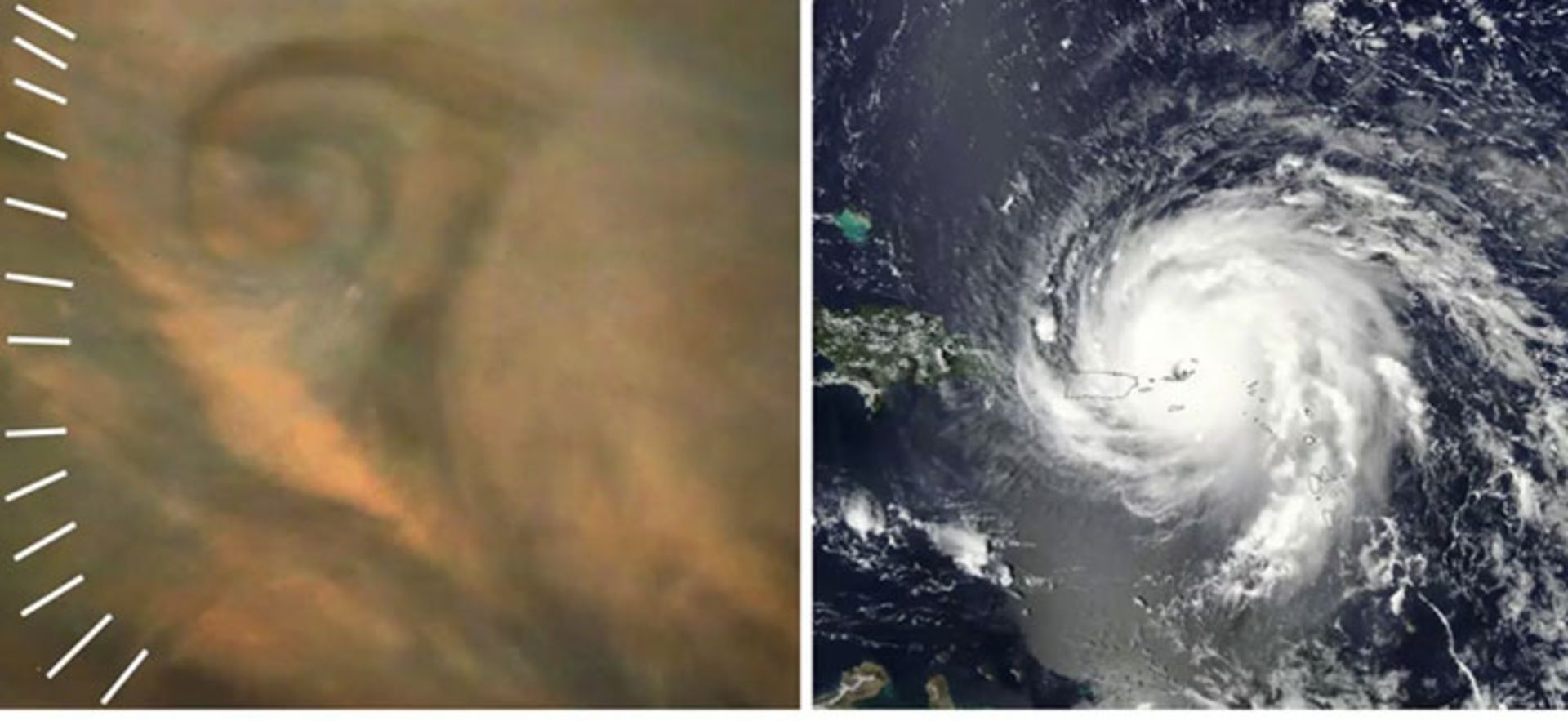
In this image taken by NASA’s Juno spacecraft, the shape of Jupiter’s atmospheric clouds resembles a tornado on Earth.
Seeing Jupiter from Earth
Jupiter is the fourth brightest object in the night sky (after the Sun, Moon, and Venus). Depending on Jupiter’s position relative to the sun and the Earth, its range of vision varies. The average visibility range of this planet is minus 2.20 and its standard deviation is 0.33.
Since the orbit of Jupiter is outside the Earth, the phase angle of this planet from the Earth never exceeds 11.5 degrees. For this reason, this planet is always seen brightly from telescopes on the ground. With a small telescope, you can even observe the Galilean moon and the cloud belts around Jupiter’s atmosphere.
Pre-telescopic researches
Jupiter’s observation dates back to Babylonian astronomers in the 7th or 8th century BC. Chinese astronomers also observed the orbit of Jupiter and based on the approximate number of years, they made its 12-branched terrestrial cycle. Ground-based telescopic research
In January 1610, Galileo Galilei examined the planet Jupiter with his small telescope. His observations changed the current understanding of the universe. Galileo observed three small stars near Jupiter. The next afternoon, he was able to see the stars again, but this time they were on the other side of the planet. Over the course of several weeks of observation, these stars moved around Jupiter. Galileo gave the name of Medici’s stars to these objects out of gratitude to his patron Cosmo de’ Medici, but today they are known as Galileo’s moons.
This observation was the first telescopic observation of the moons of the solar system (other than the Earth’s moon). A day after Galileo, Simon Marinus independently discovered the moons around Jupiter, but he did not publish the results of his discoveries until 1614. This discovery was a turning point in Copernicus’ heliocentric theory of planetary motion. Galileo was prosecuted for blasphemy for supporting this theory.

Giovanni Cassini
In the 1660s, Giovanni Cassini used a new telescope to discover Jupiter’s colorful bands and spots and was able to estimate the planet’s rotation period. In 1690, Cassini realized the difference between the rotation of Jupiter’s atmosphere and the planet itself. Probably, the Great Red Spot in the southern hemisphere of Jupiter was observed in 1664 by Robert Hooke and in 1665 by Cassini, although there is still a debate on this issue. Astronomer Henrich Schwab published the first detailed sketch of the Great Red Spot in 1831.
Both Giovanni Beverley and Cassini made detailed tables of Jupiter’s lunar motions, and based on that, they used to predict the motions of these moons. In 1892, E.E. Barnard discovered the fifth moon of Jupiter at Lake California Observatory. The discovery of this relatively small object made him famous. This moon was named Amalatha. It was the last planetary moon to be discovered directly by visual observation.
In 1932, Robert Wildt discovered the bands of ammonia and methane. Three gyres (large-scale rotation of wind around a central point of high atmospheric pressure counterclockwise) called white rings were also discovered in 1938. Finally, two rings were merged in 1998 and the third ring known as BA was absorbed in 2000.
Radiotelescopic researches
In 1955, Bernard Burke and Kenneth Franklin managed to detect bursts with a power of 22.2 MHz based on radio signals. The period of these bursts coincided with the rotation of the planet, and they used this information to correct the rotation ratio. Jupiter’s radio bursts come in two main forms: long bursts (L bursts) lasting up to several seconds, and short bursts (S bursts) lasting less than a hundredth of a second.
Jupiter probes
So far, eight spacecraft and probes have explored Jupiter: Pioneer 10 and 11, Voyager 1 and 2, Galileo, Cassini, Ulysses, New Horizons, and Juno.
Pioneer 10 and 11 (Pioneer)
Pioneer 10 and 11 were the first spacecraft to explore Jupiter. These two probes recorded the first scientific observations of Jupiter and Saturn, paving the way for the Voyager missions. The external instruments of these spacecraft investigated the atmospheres of Jupiter and Saturn, magnetic fields, moons, and rings, as well as interplanetary dust and magnetic regions, solar winds, and cosmic rays. These two probes continued their journey and left the solar system.

Picture of Pioneer 10 from Jupiter
Voyager 1 and 2
NASA sent two Voyager spacecraft to Jupiter, Saturn, Uranus, and Neptune in the late summer of 1977. Voyager 1’s closest contact with Jupiter was recorded on March 5, 1979. Voyager 2’s closest approach to this planet was recorded on July 9, 1979.
Jupiter photography began in January 1979. Voyager 1 completed its mission to Jupiter in early April after recording 19,000 images and many other science measurements. Voyager’s mission period was from late April to early August. The two spacecraft captured more than 33,000 images of Jupiter and its five moons. Voyager 1 and 2 provided researchers with a lot of information about moons, magnetic fields, and more. The biggest achievement of these two spacecraft was the discovery of active volcanoes on Io’s moon.
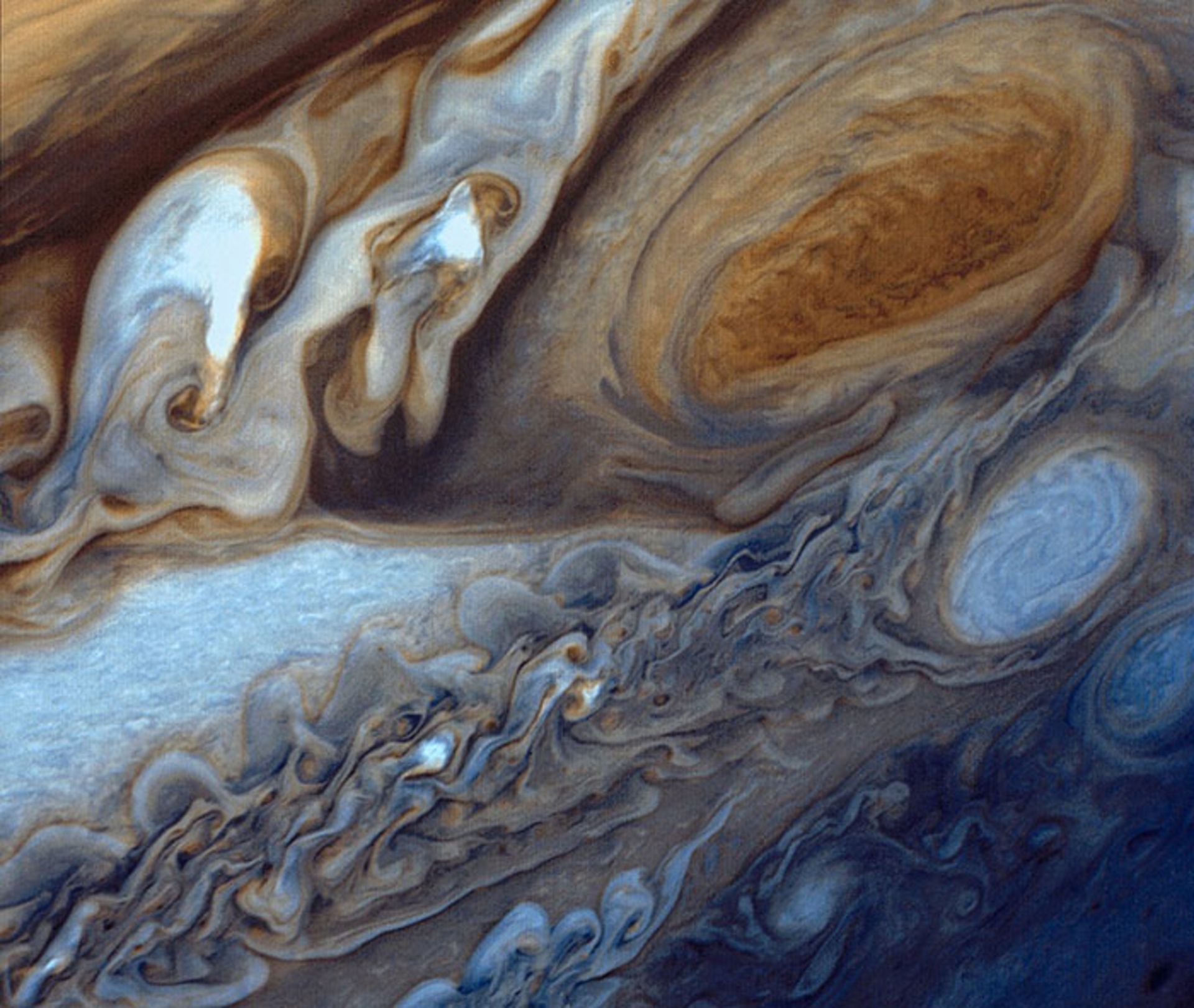
Voyager 1 image of Jupiter
Galileo Spacecraft
The Galileo spacecraft was launched on October 18, 1989, by the space shuttle Atlantis and reached Jupiter in 1995. This probe spent almost eight years in the orbit of Jupiter and studied its moons. Based on the information obtained from the camera and nine other instruments of this probe, the possibility of an ocean under the surface of Europa’s moon was investigated. According to the discoveries, the volcanoes of Io’s moon are very active. One of Galileo’s other discoveries was the distinct magnetic field of Ganymede. Galileo was carrying a small probe that was sent deep into Jupiter’s atmosphere, and about an hour later it was destroyed by high pressure.
Cassini spacecraft
Cassini was a joint collaboration between NASA the European Space Agency (ESA) and the Italian Space Agency, and its main objective was to study Saturn, its ring system, and its moons. The probe made its closest approach to Jupiter on December 30, 2000, and recorded numerous scientific measurements. Cassini captured 26,000 images of the planet, its rings, and moons during its six-month flyby around Jupiter. Cassini’s greatest achievement of Jupiter was capturing the most detailed color portrait of the planet (up to that time).
Among other Cassini observations, we can mention a dark swirling cloud in the upper part of Jupiter’s atmosphere, which was almost the same size as the Great Red Spot and is located near its north pole. Based on the evidence that Cassini obtained from Jupiter’s rings, this ring is composed of irregularly structured objects that were probably formed by the disintegration of rock from the moons Metis and Adrasta.
Ulysses spacecraft
Ulysses was the result of the joint collaboration of NASA and the European Space Agency, which was launched in October 1990, and its main purpose was to study the space region above the poles of the Sun. Since Ulysses needed a lot of energy to orbit the Sun and the Earth was unable to provide this energy, it was necessary for this spacecraft to obtain its energy from another planet. Jupiter was the closest planet that could provide the prerequisites for this journey.
Ulysses reached Jupiter 16 months after separation from Earth and made its closest approach to the planet on February 8, 1992. Although the secondary purpose of Ulysses was to study Jupiter, in this short trip he was able to obtain very useful information about the very strong magnetic field of this planet.
New Horizons spacecraft
New Horizons was an interplanetary probe built at the Johns Hopkins University Physics Laboratory (APL) and Southwest Research Institute (SwRI) and launched in 2006 to study Pluto. New Horizons used Jupiter’s gravity (320 times that of Earth) to orbit Pluto.
New Horizons used the LORRI instrument to record its images of Jupiter on September 4, 2006, from a distance of 291 million kilometers from the planet. Closer examination of Jupiter continued in January 2007 with an infrared image of Callisto’s moon and several black-and-white images of Jupiter itself.
One of the main goals of this probe was to investigate atmospheric conditions and analyze the structure of Jupiter’s clouds. For the first time, this probe was able to record close-up images of Jupiter’s small red spot. He also managed to capture images of the ring system of the planet from different angles. New Horizons captured valuable information on Jupiter’s magnetosphere as it traveled towards it.
Juno spacecraft
NASA’s Juno spacecraft was launched on August 5, 2011, and entered Jupiter’s orbit on July 5, 2016, to begin detailed scientific studies of the planet. So far, this spacecraft has orbited Jupiter 32 times and spent almost a year at a distance of 5,000 km above Jupiter’s clouds.
The purpose of the Juno mission is to measure the composition, gravitational field, magnetic field, and polar magnetosphere of this planet. It also looks for clues about how the planet formed, its rocky core, the amount of water in the deep atmosphere, its mass distribution, and its deep winds, which reach speeds of up to 610 kilometers per hour.
Unlike other probes sent to the planets of the Solar System, Juno is powered by solar arrays similar to Earth satellites, while radiative isotope thermoelectric generators are typically used for intrasolar system missions.



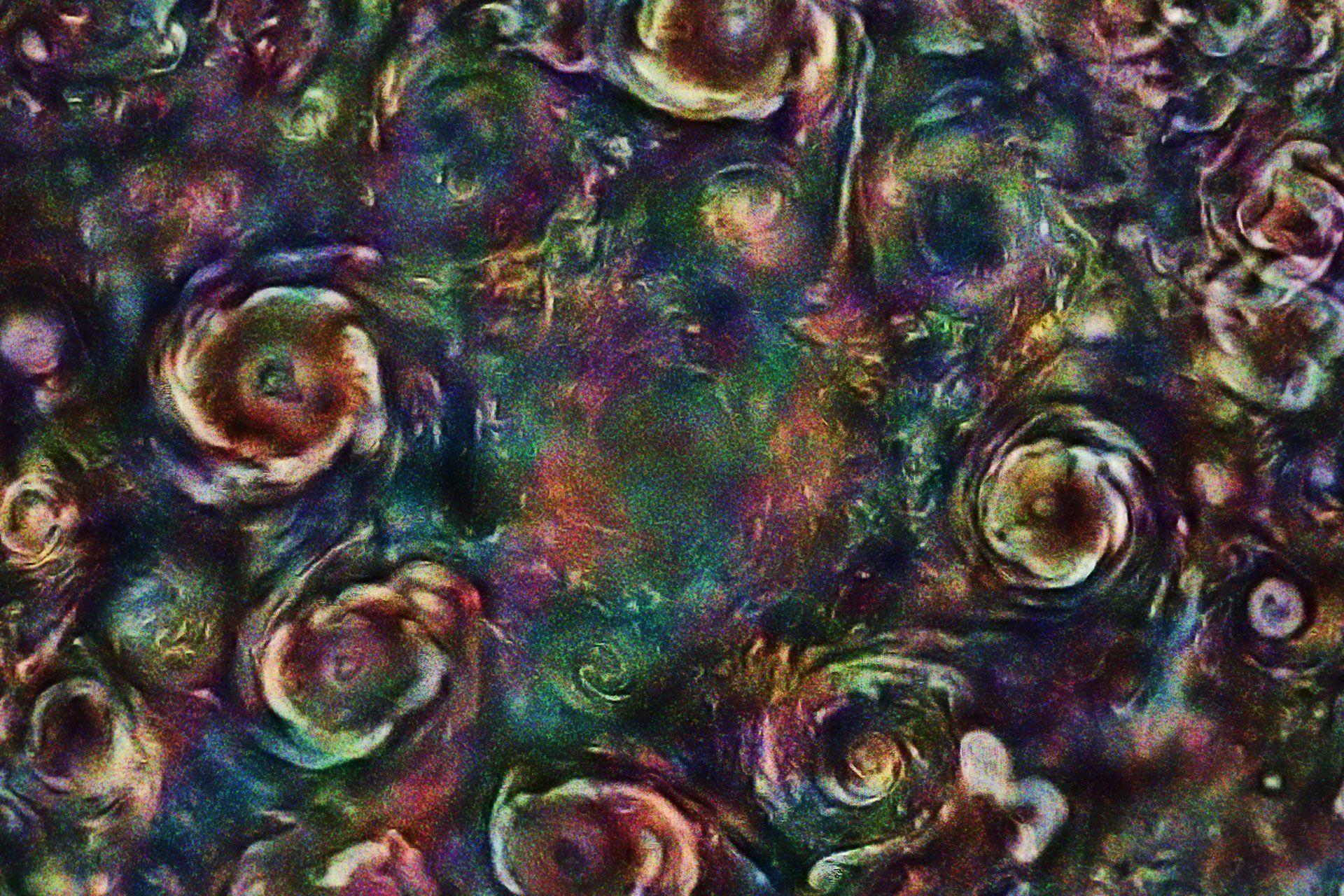




Some images recorded by the Juno probe since 2016
During Juno’s mission, its infrared and microwave instruments will measure thermal radiation from Jupiter’s atmosphere. These observations are complementary to previous investigations of the planet’s composition regarding the abundance and distribution of water and oxygen. Data provides new insights into customer origin.
Juno also made unprecedented findings about Jupiter’s atmospheric winds. Based on these findings, the atmospheric winds of this planet last longer than the atmospheric processes on Earth. Juno’s measurements of Jupiter’s gravitational field confirm the planet’s north-south asymmetry, which is similar to the asymmetry observed in the planet’s belts and bands. As the winds get deeper, their mass increases.
According to one of Juno’s other findings, there is a solid body under the weather layer of this planet. This result is surprising, and future Juno measurements will help to understand this transition from the air layer to the solid body. Before the Juno discoveries, there was no information about the atmosphere near Jupiter’s poles. According to the data obtained from this probe, Jupiter’s poles are rougher in nature compared to the more familiar white and orange belts located in the planet’s lower latitudes.
The north pole of this planet is surrounded by a central cyclone, which itself is surrounded by eight far-polar cyclones with diameters varying from 4000 to 46000 km. Jupiter’s south pole also has a central tornado that is surrounded by five other tornadoes with diameters ranging from 5,600 to 7,000 km. The Juno spacecraft is currently surveying Jupiter from the planet’s orbit, sending back stunning images, atmospheric data, and other observations about the planet.
Images by James Webb of Jupiter
The James Webb Space Telescope, which has been operating since last year, has made impressive observations in the last few months. One of these remarkable observations is the detailed images of the planet Jupiter and its auroras. Both images of this telescope are composites, that is, they are made from the combination of several images that were taken with the telescope’s near-infrared camera (NIRCam) and photographed with different filters.
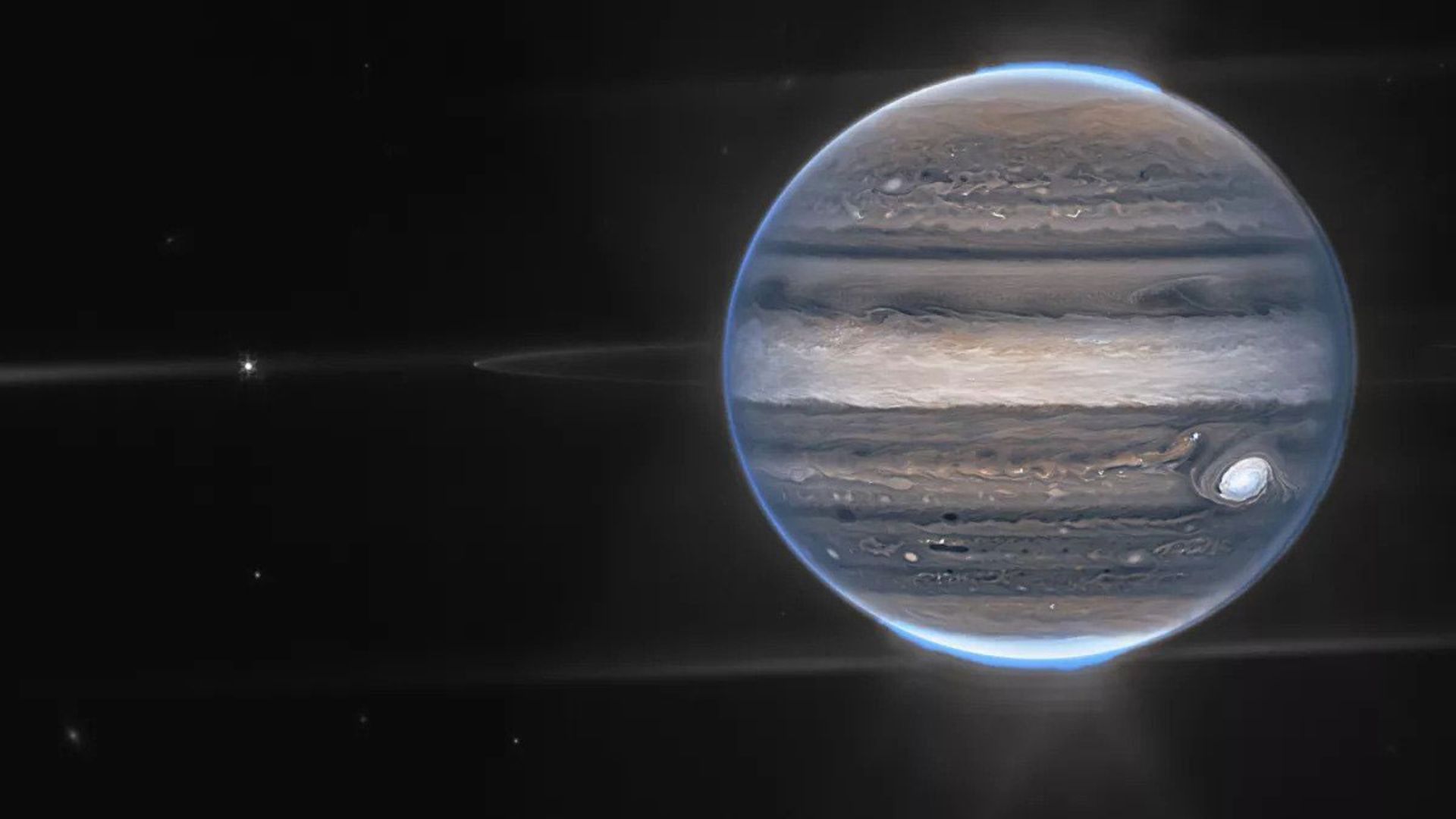
A composite image of Jupiter captured by the NIRCam camera shows the planet’s rings and its two moons, Amalthea and Adrastia. The blue halo around Jupiter’s poles are the auroras.
In the wider image, you can see Jupiter’s narrow rings as well as its two moons. In this detailed James Webb image of Jupiter, the moon Almatia is a bright dot on the left and the moon Adrastia is at the edge of the rings between Almatia and Jupiter. The second image is a close-up view of the planet Jupiter. In this image, three filters are used to capture the details of the planet’s stormy atmosphere, especially the auroras. You might be wondering why the colors in these images are not the same as what we see in other customer images. In these images, the James Webb telescope recorded light in the infrared spectrum, not the visible light spectrum; Therefore, the colors of the two images are not the same as the colors of the unaided eye. The infrared data was mapped onto the visible light spectrum so these images are “false color” rather than “true color”.
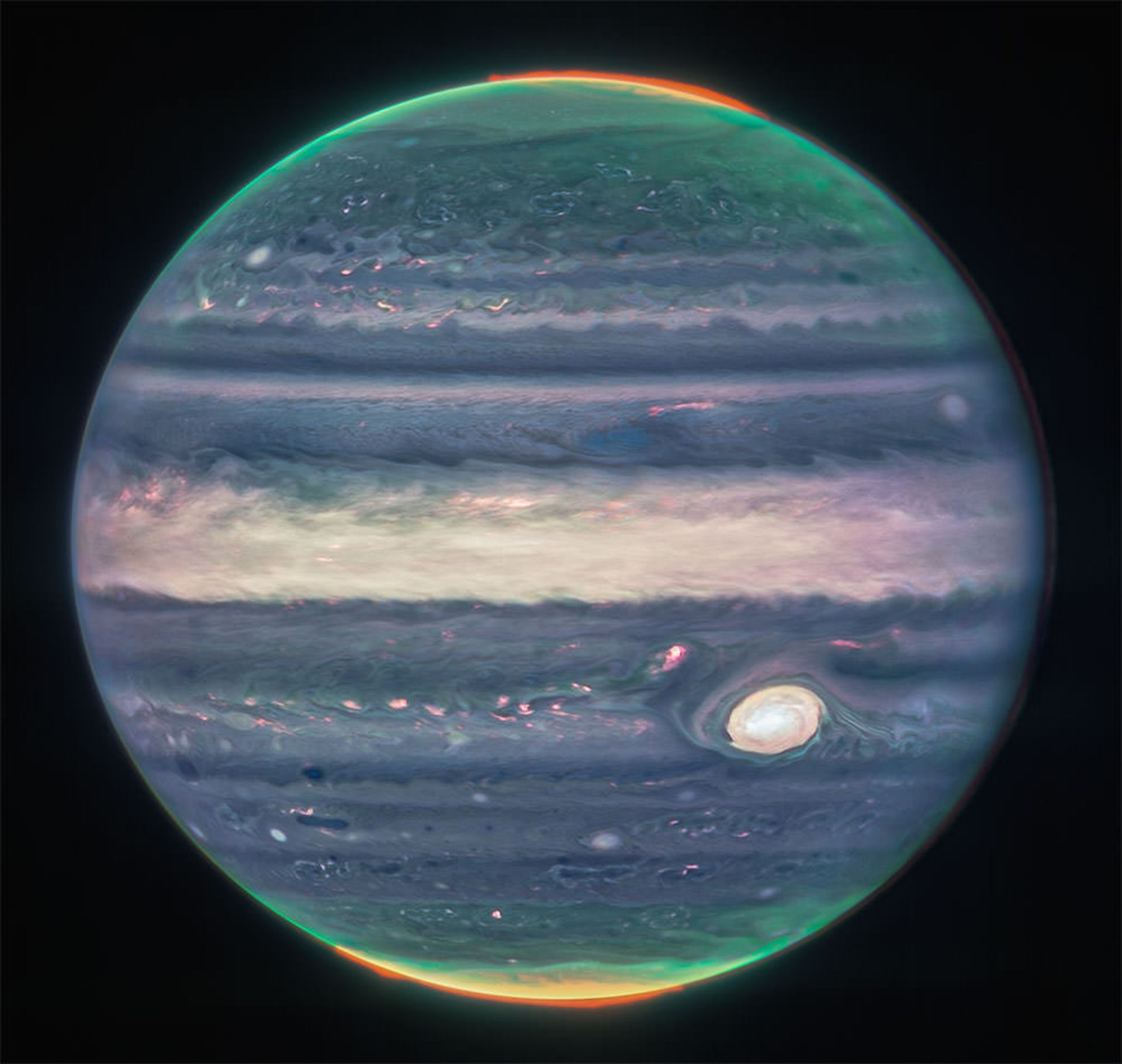
A composite image of Jupiter captured by the James Webb Space Telescope’s NIRCam camera; The orange glow around the poles are auroras.
Future missions to the client
JUICE ( Jupiter’s Icy Moons Probe): Jupiter’s Icy Moons Probe (JUICE) is a European Space Agency mission selected as part of the Cosmic Vision science program. The probe is expected to launch in 2022 and reach Jupiter in the 2030s after visits to the inner solar system. This probe is dedicated to studying the icy Galilean moons: Ganymede, Callisto, and Europa. All three moons have subsurface oceans, which increases their potential for discovering life.
Europa Clipper: NASA’s Europa Clipper probe is dedicated to the study of Europa, Jupiter’s icy moon, and will investigate the conditions of life beneath the icy crust of this moon. This probe will be placed in Jupiter’s orbit for close observation of Europa. The Europaclipper probe will be launched in the early 2020s and will reach Jupiter after a 6.5-year journey.
Chinese and Russian missions: China will also launch its first probe to Jupiter in 2029. This probe will reach Jupiter in 2036. Also, Russia is looking to send a probe to Jupiter that will be launched in 2030. This mission will last 50 months and will initially visit the Moon and Venus. Then he examines Jupiter and its moons.


You may like
-




Europa Clipper, NASA’s flagship probe was launched
-

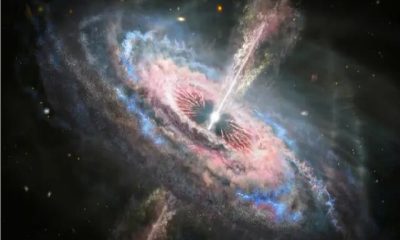


Dark matter and ordinary matter can interact without gravity!
-




James Webb Space Telescope deepens cosmology’s biggest controversy
-

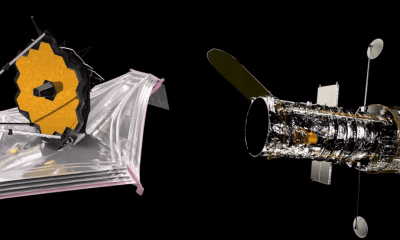


James Webb vs. Hubble
-

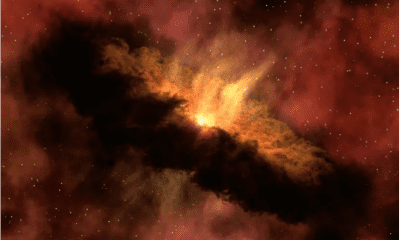


There is more than one way for planets to be born
-




Why is Jupiter one of the first targets of the James Webb Space Telescope?


Europa Clipper, NASA’s flagship probe was launched
After years of waiting, NASA’s Europa Clipper probe was finally launched on Monday at 7:36 p.m. Iran time from the Kennedy Space Center on top of SpaceX’s Falcon Heavy rocket and began a major astrobiology mission to Europa, the potentially habitable moon of Jupiter.
As SpaceX’s massive rocket powered by 27 powerful Merlin engines lifted off from pad 39A, NASA live broadcast reporter Dron Neal said, “The launch of Falcon Heavy with Europa Clipper will reveal the secrets of the vast ocean beneath the icy crust of Europa, Jupiter’s moon. It has been hidden, it will reveal.”
The engines of the two side boosters of the Falcon Heavy were shut down and separated from the central booster approximately three minutes after the flight. The central booster continued to fly for another minute, and then in the fourth minute of the launch, the separation of the upper stage from the first stage was confirmed. Finally, 58 minutes later, Europa Clipper was injected into interplanetary orbit as scheduled. A few minutes later, the mission team made contact with the probe, and people in the control room cheered and applauded.
Falcon Heavy’s unique launch
The launch of NASA’s new probe was delayed due to some mishaps. NASA and SpaceX initially planned to launch the Europa Clipper mission on Thursday, October 10; But with powerful Hurricane Milton hitting Florida’s Gulf Coast on Wednesday evening, a delay in the launch became inevitable. NASA shut down Kennedy Space Center to deal with the storm, and Europa Clipper was placed inside SpaceX’s hangar near Launch Pad 39A.
The recent launch was Falcon Heavy’s 11th flight overall and its second interplanetary mission. Also, this was the first flight of the Falcon Heavy, when all three boosters of the first stage of the rocket were deployed.
Typically, the Falcon Heavy and Falcon 9 first-stage boosters store enough fuel to perform landing maneuvers for recovery and reuse in the future; But Europa Clipper needed all the power that Falcon Heavy could provide in order to make it on its way to the Jupiter system.
A long way to the launch pad
In late 2015, the US Congress directed NASA to launch Europa Clipper using the Space Launch System (SLS), NASA’s massive rocket. SLS was still under construction at the time and was several years away from reaching the launch pad. The delay in completing the construction of this powerful rocket and NASA’s need to assign at least the first three versions of SLS to the Artemis lunar mission caused the Europa Clipper launch date to be in an aura of uncertainty.
In the 2021 House budget draft for NASA, the agency was directed to launch Europa Clipper by 2025 and, if possible, with SLS. However, due to the unavailability of the Space Launch System, NASA had to go to SpaceX’s Falcon Heavy. This decision was not without cost. As the most powerful rocket ever used in an operational mission, SLS can send Europa Clipper directly to the Jupiter system in less than three years.
Europa Clipper will use the gravitational assistance of Mars and Earth on its way to the Jupiter system
Now, even in Falcon Heavy’s fully disposable mode, the Clipper’s trip to Europe takes almost twice as long. The probe should make a flyby of Mars in February 2025 and a flyby of Earth in December 2026 to gain enough speed to reach its destination in April 2030.
Missile problems were not the only obstacles facing Europa Clipper on its way to the launch pad. For example, the rising costs of this five billion dollar probe forced NASA to cancel the construction of one of the probe’s science instruments. This instrument, named “Identification of Europa’s internal features using a magnetometer” (ICEMAG), was designed to measure Europa’s magnetic field.
Then in May 2024, NASA found that transistors similar to those used in Europa Clipper, which are responsible for regulating the probe’s electricity, were “failing at lower-than-expected radiation doses.” Following this discovery, NASA conducted more tests on the transistors and finally concluded in late August that these components could support the initial mission in the radiation-rich environment around Jupiter.
Ambitious mission to a fascinating moon

NASA/Jet Propulsion Laboratory-Caltech
Europa Clipper is one of NASA’s most exciting and ambitious flagship missions, and it has impressive features. For example, the mission probe is the largest spacecraft NASA has ever built for a planetary mission. Europa Clipper weighed almost 6,000 kg at the time of launch and will be more than 30 meters long (bigger than a basketball court) by opening its huge solar panels in space.
Clipper’s Europa destination is also a prominent location: Europa, one of Jupiter’s four Galilean moons. The moon is covered with an icy outer shell, which scientists believe hides a vast ocean of salty liquid water. For this reason, Europa is considered one of the best places in the solar system to support alien life.
In early 2012, studies began to look for potential plumes of water rising from Europa’s surface. Some researchers theorize that those water columns and vents from which the columns protrude may contain evidence of life living beneath the moon’s icy crust. However, NASA scientists have made it clear that Europa Clipper is not looking for extraterrestrial life in Europa; Rather, this probe will only investigate the potential of the submoon water environment to support life.
“If there’s life on Europa, it’s going to be under the ocean,” Bonnie Buratti, senior Europa Clipper scientist at NASA’s Jet Propulsion Laboratory, said in September. As a result, we cannot see it.” “We will be looking for organic chemicals that are prerequisites for life on the surface of the moon,” Borrati added. There are things we can observe; such as DNA or RNA; But we don’t expect to see them. As a result, [the probe] is only looking for habitable environments and evidence for the ingredients of life, rather than life itself.”
NASA scientists have made it clear that Europa Clipper is not looking for extraterrestrial life in Europa
Europa Clipper will collect data using a suite of nine scientific instruments, including visible and thermal cameras, several spectrometers, and special equipment to identify Europa’s magnetic environment. As stated on NASA’s Europa Clipper page, the probe will help scientists achieve three main goals:
- Determining the thickness of Europa’s ice sheet and understanding how Europa’s ocean interacts with the lunar surface.
- Investigating the composition of Europa’s ocean to determine whether it has the materials necessary to form and sustain life.
- Studying the formation of Europe’s surface features and discovering signs of recent geological activities; such as the sliding of crustal plates or the discharge of water columns in space.
Europa Clipper also transports Earth’s culture to the Solar System. A piece called “In Praise of Mystery: A Poem for Europe” by Edda Lemon, a famous American poet, is engraved in the artist’s own handwriting on a metal plate. In addition, the probe carries a coin-sized chip that contains the names of 2.6 million inhabitants of planet Earth.
6-year journey

Johns Hopkins University Applied Physics
If all goes according to plan, Europa Clipper will enter Jupiter’s orbit in April 2030. When the probe gets there, it will use up 50-60% of its 2,722 kg of fuel by performing an injection maneuver for 6-8 hours.
The injection maneuver puts Europa Clipper in an elliptical orbit around the gas giant. A series of long maneuvers will then be performed to align the trajectory so that the probe can fly by Europa more than 45 times and study it closely. In fact, Europa Clipper will remain around Jupiter throughout its mission; Because according to the launch environment of Europa, it will be very dangerous for the spacecraft to go around the moon.
If all goes according to plan, Europa Clipper will enter Jupiter’s orbit in April 2030
The first flight over Europe will not take place before the spring of 2031. NASA will use the first pass to make further corrections to Europa Clipper’s trajectory in preparation for the probe’s first science mission. With the start of scientific flybys in May 2031, Europa Clipper will aim its array of sensors towards the far hemisphere from Jupiter and will approach the surface of the moon up to 25 km. The second science campaign will begin two years later, in May 2033, in the Jupiter-facing hemisphere of Europa.
The end of the Europa Clipper mission is set for September 2034. At that time, NASA will crash the spacecraft into Ganymede, another Galilean moon of Jupiter. This disposal strategy was chosen because Ganymede is considered a relatively poor candidate to host life, and the mission team wanted to make sure they did not contaminate potentially life-hosting Europa with terrestrial microbes.
Space
Dark matter and ordinary matter can interact without gravity!
Published
2 weeks agoon
01/10/2024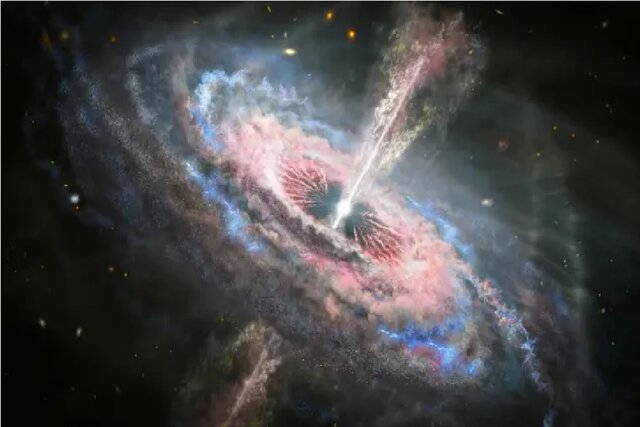

Preposition: For each; per.
Noun: A topology name.
Noun: which has mass but which does not readily interact with normal matter except through gravitational effects.
Adverb: Beyond all others.
Preposition: For each; per.
Noun: A topology name.
Dark matter and ordinary matter can interact without gravity!
Why is dark matter associated with the adjective “dark”? Is it because it harbors some evil forces of the universe or hidden secrets that scientists don’t want us to know? No, it is not. Such fanciful assumptions may sound appealing to a conspiracy theorist, but they are far from the truth.
Dark matter is called dark because it does not interact with light. So when dark matter and light collide, they pass each other. This is also why scientists have not been able to detect dark matter until now; it does not react to light.
Although it has mass and mass creates gravity, this means that dark matter can interact with normal matter and vice versa. Such interactions are rare, and gravity is the only known force that causes these two forms of matter to interact.
However, a new study suggests that dark matter and ordinary matter interact in ways other than gravity.
If this theory is correct, it shows that our existing models of dark matter are somewhat wrong. In addition, it can lead to the development of new and better tools for the detection of dark matter.
Read more: There is more than one way for planets to be born
A new missing link between dark and ordinary matter
Dark matter is believed to have about five times the mass of normal matter in our universe, which helps hold galaxies together and explains some of the motions of stars that don’t make sense based on the presence of visible matter alone.
For example, one of the strongest lines of evidence for the existence of dark matter is the observation of rotation curves in galaxies, which show that stars at the outer edges of spiral galaxies rotate at rates similar to those near the center. These observations indicate the presence of an invisible mass.
Also, for their study, the researchers studied six ultra-dim dwarf (UFD) galaxies located near the Milky Way. However, in terms of their mass, these galaxies have fewer stars than they should. This means they are mostly made up of dark matter.
According to the researchers, if dark matter and normal matter interact only through gravity, the stars in these UFDs should be denser in the centers and more spread out toward the edges of the galaxies. However, if they interact in other ways, the star distribution looks different.
The authors of the study ran computer simulations to investigate both possibilities. When they tested this for all six ultra-dim dwarf (UFD) galaxies, they found that the distribution of stars was uniform, meaning that the stars were spread evenly across the galaxies.
This was in contrast to what is generally observed for gravitational interactions between dark matter and normal matter.
What causes this interaction?
The results of the simulations showed that gravity is not the only force that can make dark matter and normal matter interact. Such an interaction has never been observed before, and it could change our understanding of dark matter and dark energy.
However, this study has a major limitation. What caused the interaction between the two forms of matter is still a mystery. While the current study provides tantalizing hints of a novel interaction, its exact nature and underlying causes remain unknown. Hopefully, further research will clarify the details of such interactions.
This study was published in The Astrophysical Journal Letters.
Space
James Webb Space Telescope deepens cosmology’s biggest controversy
Published
3 weeks agoon
26/09/2024

How the James Webb Space Telescope deepens cosmology’s biggest controversy
Summary of the article:
- Almost a century ago, Edwin Hubble discovered the expansion of the universe and calculated the expansion rate or the cosmic constant.
- Since Hubble, many groups have tried to measure the expansion rate of the universe. However, the values they obtained differed from the theoretical predictions. This difference is called Hubble tension.
- Scientists today use three methods to measure the expansion rate of the universe: Cephasian variable stars, TRGB red giant stars, and JAGB asymptotic giants.
- However, the Hubble tension still exists, indicating that the methods for calculating the Hubble constant suffer from a systematic flaw.
- Researchers hope to be able to use the James Webb telescope in the coming years to achieve more accurate measurements of the universe’s expansion rate and thus resolve the Hubble tension.
Almost a century ago, Edwin Hubble discovered that the universe was getting bigger. However, today’s measurements of how fast the universe is expanding are contradictory. These discrepancies show that our understanding of the laws of physics may be incomplete. On the other hand, everyone expected the sharp eyes of the James Webb telescope to bring us closer to the answer to the riddle; But a new analysis of the telescope’s long-awaited observations once again reflects inconsistent expansion rates from different types of data, while pointing to possible sources of error.
Two competing groups have led efforts to measure the rate of expansion of the universe, known as Hubble’s constant, or H0. A group led by Adam Reiss of Johns Hopkins University, relying on the known constituents of the universe and the governing equations, has consistently calculated the Hubble constant to be approximately 8 percent higher than the theory predicts the universe’s expansion rate. This discrepancy, known as the Hubble tension, indicates that the model of the cosmological theory may have missed some elements such as raw materials or effects that speed up the expansion of the universe. Such an element can be a clue to a more complete understanding of the world.
This spring, Reiss and his team published new measurements of the Hubble constant based on data from the James Webb Telescope and found a value consistent with their previous estimates. However, a rival group led by Wendy Friedman of the University of Chicago warns that more precise measurements are needed. The team’s measurements of the Hubble constant are closer to the theoretical estimate than Riess’ calculations, suggesting that the Hubble stress may not be real.
Since the commissioning of the James Webb Telescope in 2022, the astrophysical community has been waiting for Friedman’s multidimensional analysis based on telescope observations of three types of stars. The results are now as follows: the two-star types provide estimates of the Hubble constant that are in line with the theoretical prediction; While the results of the third star, which is the same type used by Reiss, are consistent with his team’s higher estimates of Hubble’s constant. According to Friedman, the fact that the results of the three methods are contradictory does not mean that there are unknown physical foundations, but that there are some systematic errors in the calculation methods.
Contradictory world
The difficult part of measuring cosmic expansion is measuring the distance of space objects. In 1912, American astronomer Henrietta Levitt first used pulsating stars known as Cephasian variables to calculate distances. These stars flicker at a rate proportional to their intrinsic luminosity. By understanding the luminosity or radiant power of a Cephasian variable, we can compare it with its apparent brightness or dimming to estimate its galaxy’s distance from us.
Edwin Hubble used Levitt’s method to measure the distances to a set of galaxies hosting the Cephasian variable, and in 1929 he noticed that the galaxies that are farther away from us are moving away faster. This finding meant the expansion of the universe. Hubble calculated the expansion rate to be a constant value of 500 km/s per megaparsec. In other words, two galaxies that are 1 megaparsec or approximately 3.2 million light years apart are moving away from each other at a speed of 500 km/s.
As progress was made in calibrating the relationship between the pulsation frequency of Cepheids and their luminosity, measurements of the Hubble constant improved. However, since the Cephasian variables are very bright, the whole approach used has limitations. Scientists need a new way to measure the distance of galaxies from each other in the infinite space.
In the 1970s, researchers used Cephasian variables to measure the distance to bright supernovae, and in this way they achieved more accurate measurements of the Hubble constant. At that time, as now, two research groups undertook the measurements, and using supernovae and Cephasian variable stars, they achieved contradictory values of 50 km/s per megaparsec and 100 km/s per megaparsec. However, no agreement was reached and everything became completely bipolar.
 Edwin Hubble, the American astronomer who discovered the expansion of the universe, stands next to the Schmidt telescope at the Palomar Observatory in this photo from 1949.
Edwin Hubble, the American astronomer who discovered the expansion of the universe, stands next to the Schmidt telescope at the Palomar Observatory in this photo from 1949.
The launch of the Hubble Space Telescope in 1990 gave astronomers a new and multi-layered view of the universe. Friedman led a multi-year observing campaign with Hubble, and in 2001 he and his colleagues estimated the expansion rate to be 72 km/s/Mpa with an uncertainty of at most 10%.
A Nobel laureate for the discovery of dark energy, Reiss got into the expansion game a few years later. In 2011, his group found the Hubble constant to be 73 with a three percent uncertainty. Soon after this, cosmologists excelled in another way. In 2013, they used Planck’s observations of light left over from the early universe to determine the exact shape and composition of the early universe.
In the next step, the researchers connected their findings to Einstein’s theory of general relativity and developed a theoretical model to predict the current state of the universe, up to approximately 14 billion years into the future. Based on these calculations, the universe should be expanding at an approximate rate of 67.4 km/s per megaparsec with an uncertainty of less than one percent.
Reese’s team measurement remained at 73, even with the improved accuracy. This higher value indicates that the galaxies today are moving away from each other at a faster rate than theoretically expected. This is how the Hubble tension was born. According to Reiss, today’s Hubble tension shows us that something is missing in the cosmological model.
The missing factor could be the first new element in the universe to be discovered since dark energy. Theorists still have doubts about the identity of this agent. Perhaps this force is some kind of repulsive energy that lasted for a short time in the early universe, or perhaps it is the primordial magnetic fields created during the Big Bang, or perhaps what is being missed is more about ourselves than the universe.
Ways of seeing
Some cosmologists, including Friedman, suspected that unknown errors were to blame for Hubble’s tension. For example, Cephasian variable stars are located in the disks of younger galaxies in regions full of stars, dust, and gas. Even with Hubble’s fine resolution, you don’t see a single Cephasian variable, according to George Afstatio, an astrophysicist at the University of Cambridge. Rather, you see it overlapping with other stars. This density of stars makes measurements of brightness difficult.
When the James Webb Telescope launches in 2021, Reiss and his colleagues will use its powerful infrared camera to peer into the crowded regions that host the Cephasian variables. They wanted to know whether the claims of Friedman and other researchers about the effect of the area’s crowding on the observations were correct.
 The 6.5-meter multi-section mirror of the James Webb Space Telescope at NASA’s Goddard Space Flight Center in Maryland. This mirror passed various test stages in 2017.
The 6.5-meter multi-section mirror of the James Webb Space Telescope at NASA’s Goddard Space Flight Center in Maryland. This mirror passed various test stages in 2017.
When the researchers compared the new numbers to distances calculated from Hubble data, they saw a surprising match. The latest results from the James Webb telescope confirmed the Hubble constant measured by the Hubble telescope a few years ago: 73 km/s/Mpa with a difference of one kilometer or so.
Concerned about crowding, Friedman turned to alternative stars that could serve as distance indicators. These stars are found in the outer reaches of galaxies and away from the crowd. One of those stars belongs to the group ” Red Giant Branch ” or TRGB for short. A red giant is an old star with a puffy atmosphere that shines brightly in the red light spectrum. As a red giant ages, it eventually burns helium in its core, and at this point, the star’s temperature and brightness suddenly decrease.
A typical galaxy has many red giants. If you plot the brightness of these stars against their temperature, you reach a point where the brightness drops off. The star population before this brightness drop is a good distance indicator; Because in each galaxy, such a population has a similar distribution of luminosity. By comparing the brightness of these star populations, astronomers can estimate their relative distances.
The Hubble tension shows that the standard model of the cosmos is missing something
Regardless of the method used, physicists must calculate the absolute distance of at least one galaxy as a reference point in order to calibrate the entire scale. Using TRGB as a distance index is more complicated than using Kyphousian variables. MacKinnon and colleagues used nine wavelength filters from the James Webb telescope to understand how brightness relates to their color.
Astronomers are also looking for a new indicator: carbon-rich stars that belong to a group known as the “Jay region asymptotic giant” (JAGB). These stars are far from the bright disk of the galaxy and emit a lot of infrared light. However, it was not possible to observe them at long distances until James Webb’s launch.
Friedman and his team have applied for observation time with the James Webb Space Telescope in order to observe TRGBs and JAGBs, along with more fixed spacing indices and Cephasian variables, in 11 galaxies.
The vanishing solution
On March 13, 2024, Friedman, Lee, and the rest of the team meet in Chicago to find out what they’ve been hiding from each other. Over the past months, they were divided into three groups, each tasked with measuring distances to 11 galaxies using one of three methods: Cephasian variable stars, TRGBs, and JAGBs.
These galaxies also host related types of supernovae, so their distances can calibrate the distances of supernovae in many more distant galaxies. The rate at which galaxies move away from us divided by their distance gives the value of the Hubble constant.
 Wendy Friedman at the University of Chicago is trying to fit the James Webb Telescope observations into the Standard Cosmological Model.
Wendy Friedman at the University of Chicago is trying to fit the James Webb Telescope observations into the Standard Cosmological Model.
Three groups of researchers calculated distance measures with a unique, random counterbalancing value added to the data. During the face-to-face session, they removed those values and compared the results.
All three methods obtained similar distances with three percent uncertainty. Finally, the group calculated three values of Hubble’s constant for each distance index. All values were within the theoretical prediction range of 67.4. Therefore, Hubble’s tension seemed to be resolved. However, they ran into problems with further analysis to write the results.
The JAGB analysis was good, But the other two were wrong. The team found that there were large error bars in the TRGB measurements. They tried to minimize the errors by including more TRGBs; But when they started doing this, they found that the distance to the galaxies was less than they first thought. This change caused the value of Hubble’s constant to increase.
Friedman’s team also discovered an error in Cephaus’s analysis: in almost half of the pulsating stars, the term crowd was applied twice. Correcting this error increased the value of Hubble’s constant significantly. Hubble’s tension was revived.
Finally, after efforts to fix the errors, the researchers’ paper presents three distinct values of Hubble’s constant. The JAGB measurement yielded a result of 67.96 km/s/megaparsec. The TRGB result was equal to 69.85 with similar error margins. Hubble’s constant was obtained at a higher value of 72.05 in the Kyphousian variable method. In this way, different hypotheses about the characteristics of these stars caused Hubble’s stress value to vary from 69 to 73.
By combining the aforementioned methods and uncertainties, the average Hubble stress value equal to 69.96 was obtained with an uncertainty of four percent. This margin of error overlaps with the theoretical prediction of the expansion rate of the universe, as well as the higher value of Tim Reiss.
Tensions and resolutions
The James Webb Space Telescope has provided methods for measuring the Hubble constant. The idea is simple: closer galaxies look more massive; Because you can make out some of their stars, while more distant galaxies have a more uniform appearance.
A method called gravitational convergence is more promising. A massive galaxy cluster acts like a magnifying glass, bending and magnifying the image of a background object, creating multiple images of the background object when its light takes different paths.
Brenda Fry, an astronomer at the University of Arizona, is leading a program to observe seven clusters with the James Webb Space Telescope. Looking at the first images they captured last year of the G165 cluster, Fry and his colleagues noticed three spots that were not previously seen in the images. These three points were actually separate images of a supernova that was located in the background of the aforementioned cluster.
After repeating the observation several times, the researchers calculated the difference between the arrival times of the three gravitational lensing images of the supernova. This time delay is proportional to Hubble’s constant and can be used to calculate this value. The group obtained an expansion velocity of 75.4 km/s/Mpa with a large uncertainty of 8.1%. Fry expects the error bars to correct after several years of similar measurements.
Both Friedman’s and Reiss’ teams predict that they will be able to get a better answer with James Webb’s observations in the coming years. “With improved data, the Hubble tension will eventually be resolved, and I think we’ll get to the bottom of it very quickly,” Friedman says.


Biography of Geoffrey Hinton; The godfather of artificial intelligence


The Secret of the Hummingbird’s Amazing Adaptation


Europa Clipper, NASA’s flagship probe was launched


How did accidental release cause the 1977 Russian flu?


Everything about Cybercube and Robo Van; Elon Musk’s robotic taxis


The biography of Andy Rubin, the creator of Android


The Strawberry Project; The OpenAI artificial intelligence model


Why doesn’t Jupiter have big and bright rings like Saturn?


Everything you need to know about the Windows Blue Screen of Death


How to prevent your location from being revealed through photos?
Popular
-



 Technology1 year ago
Technology1 year agoWho has checked our Whatsapp profile viewed my Whatsapp August 2023
-



 Technology1 year ago
Technology1 year agoSecond WhatsApp , how to install and download dual WhatsApp August 2023
-



 Technology1 year ago
Technology1 year agoHow to use ChatGPT on Android and iOS
-



 AI2 years ago
AI2 years agoUber replaces human drivers with robots
-



 Technology1 year ago
Technology1 year agoThe best Android tablets 2023, buying guide
-



 Technology1 year ago
Technology1 year agoThe best photography cameras 2023, buying guide and price
-



 Humans2 years ago
Humans2 years agoCell Rover analyzes the inside of cells without destroying them
-



 Technology1 year ago
Technology1 year agoHow to prevent automatic download of applications on Samsung phones
